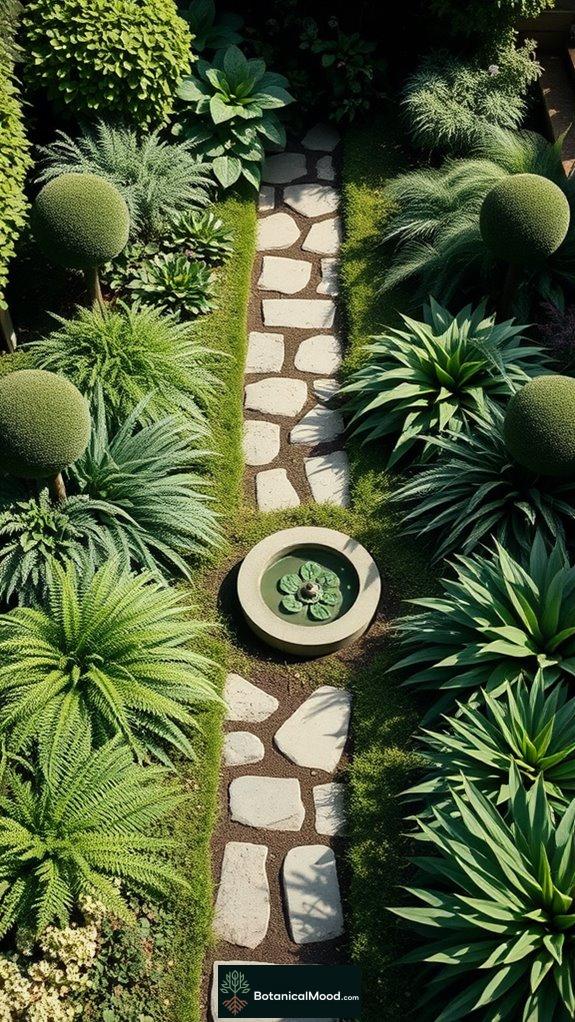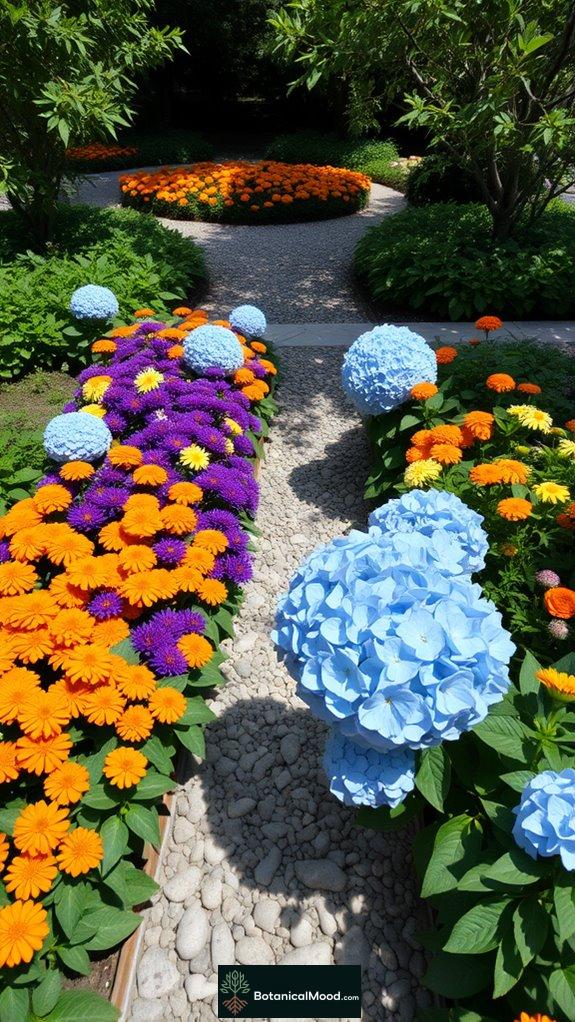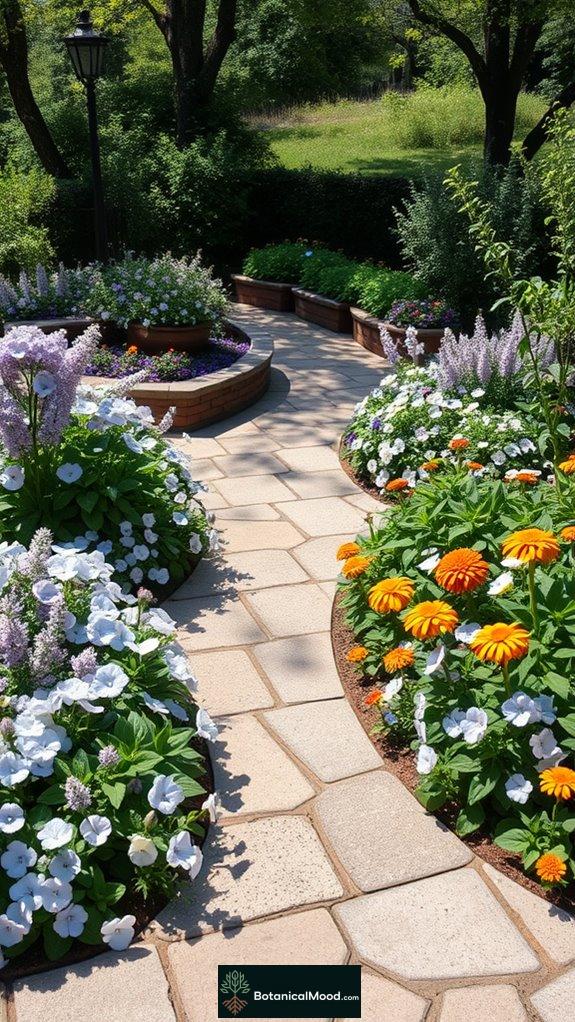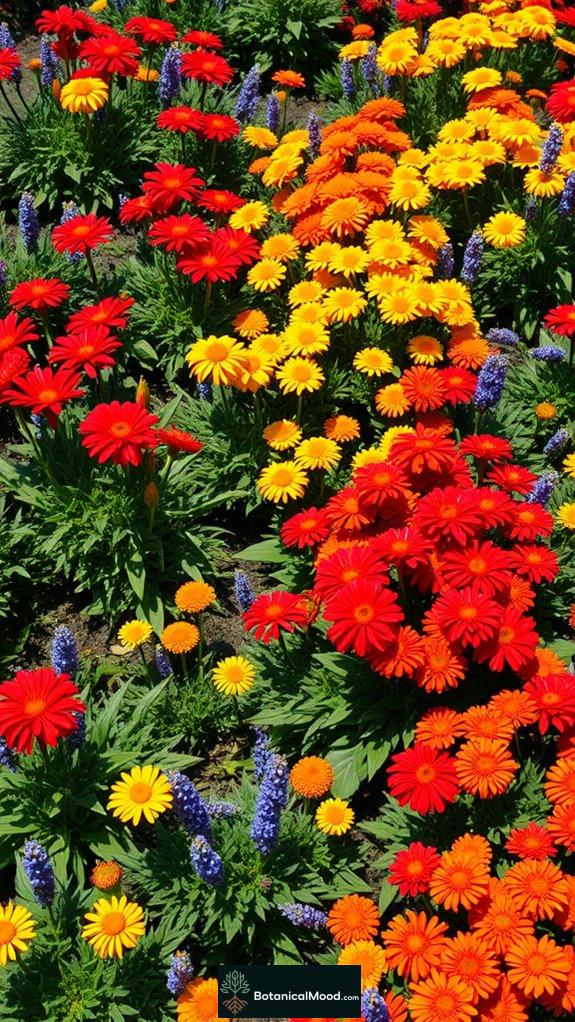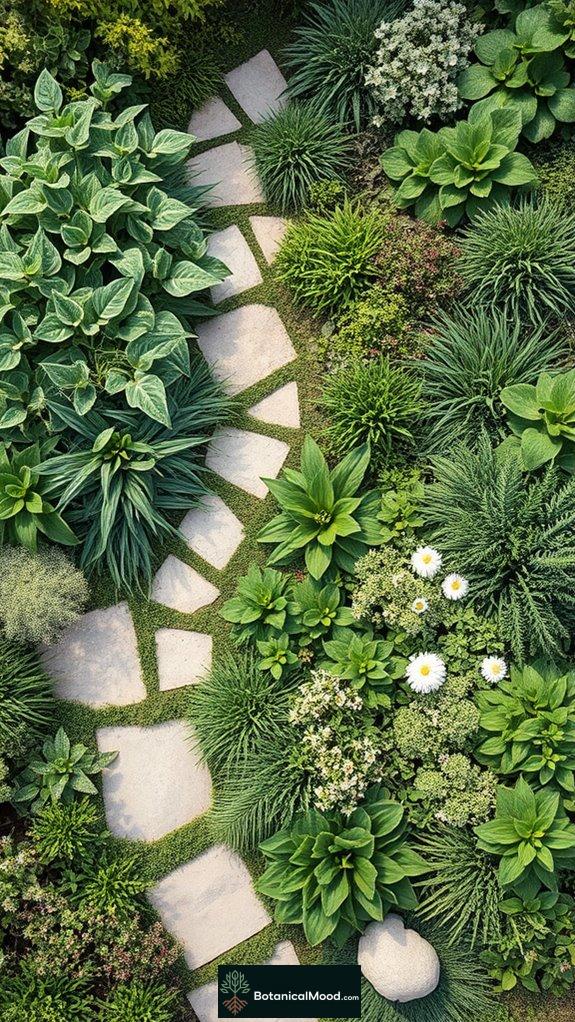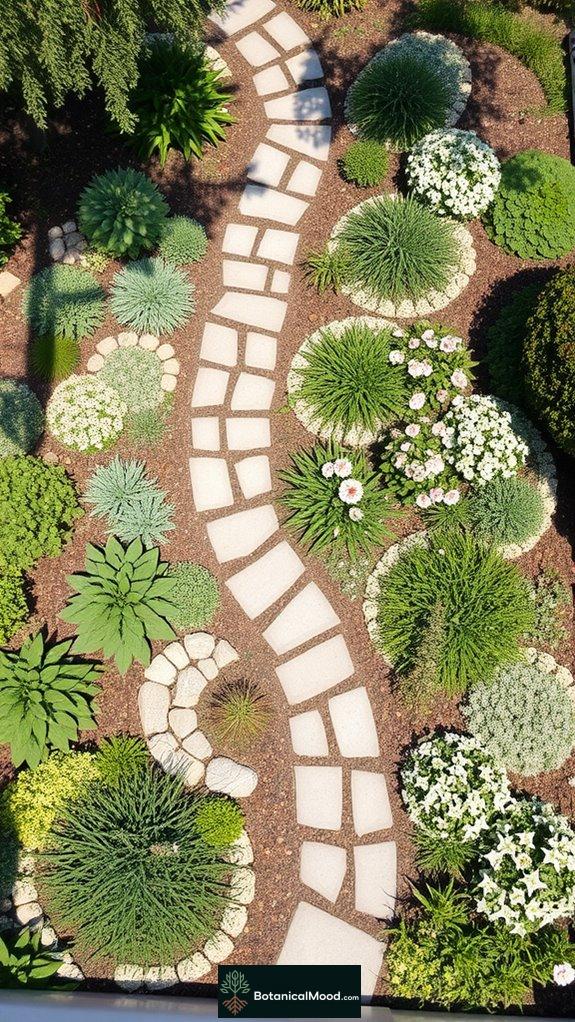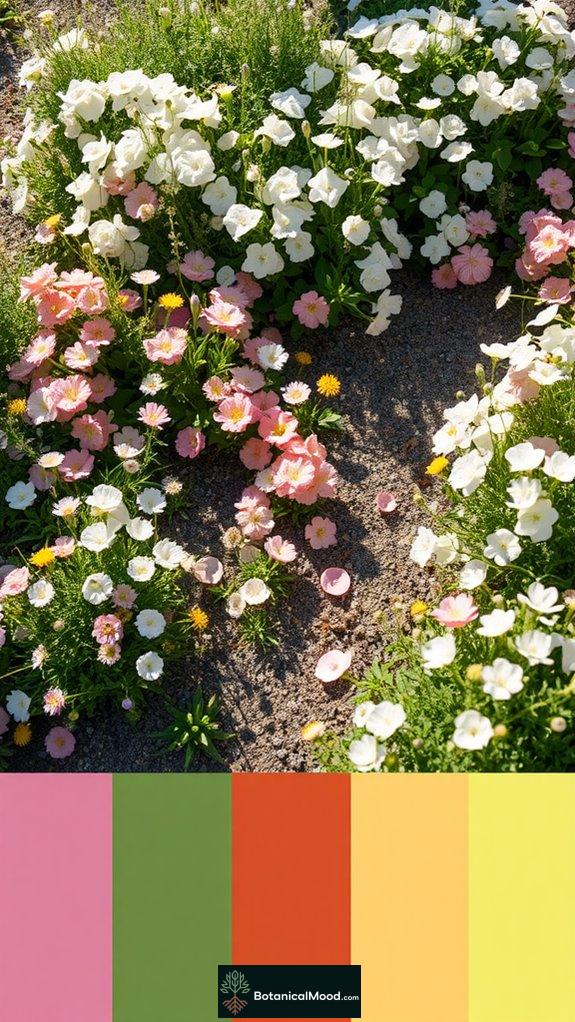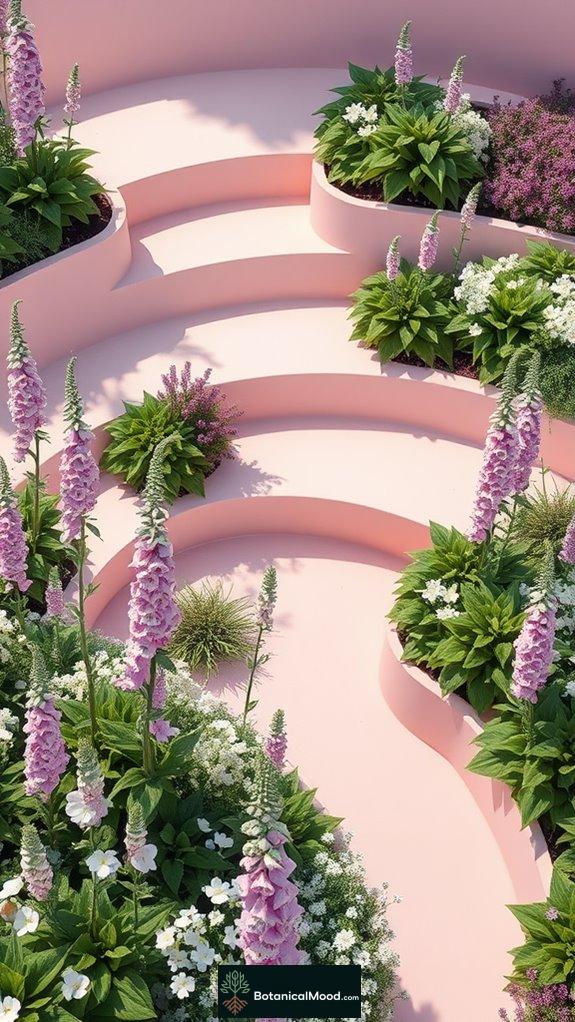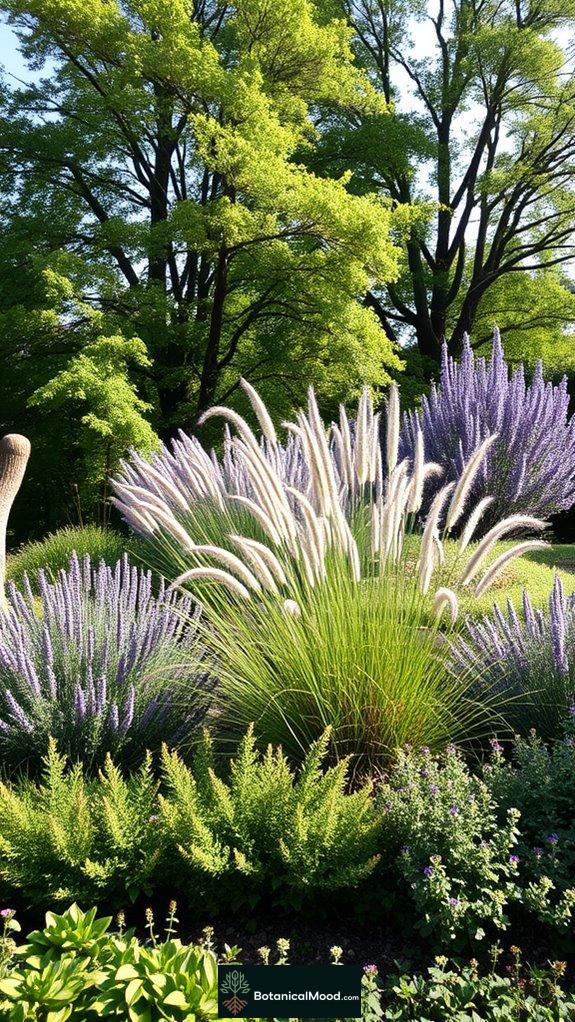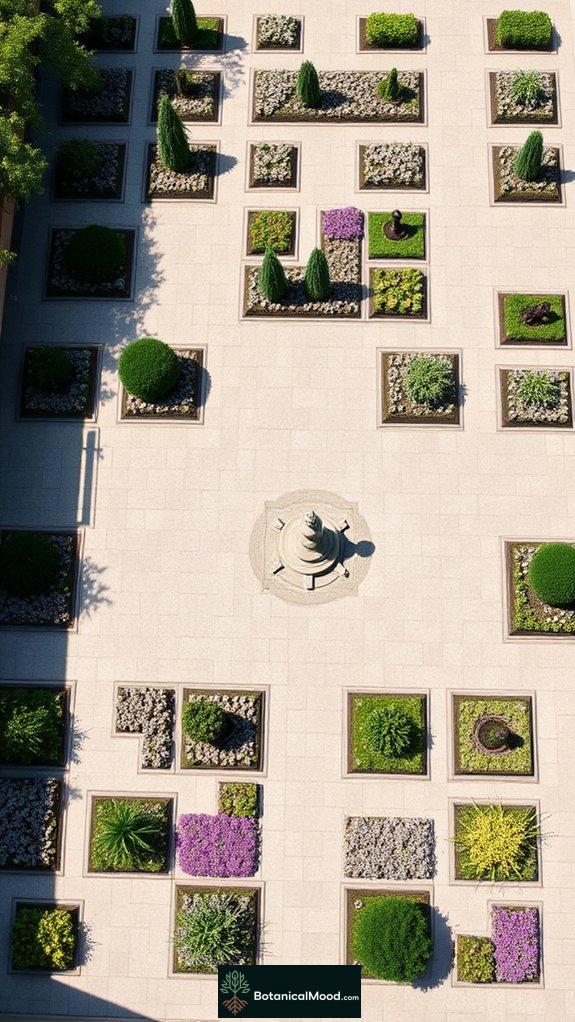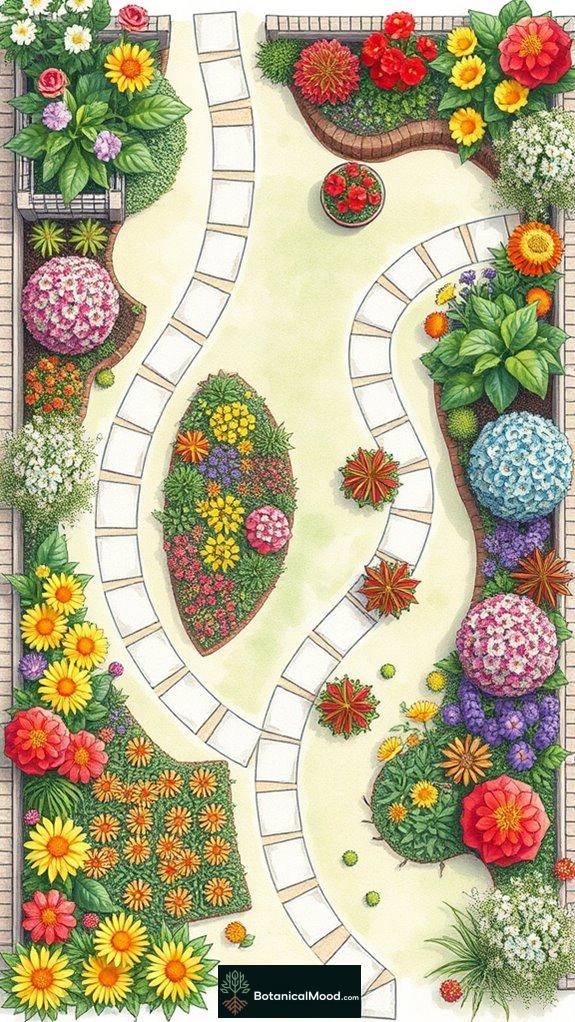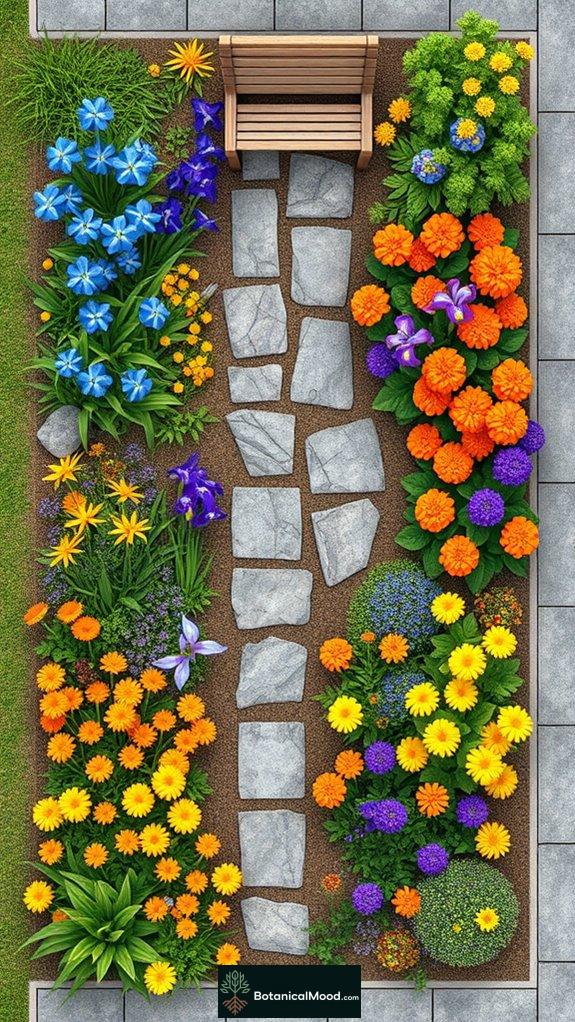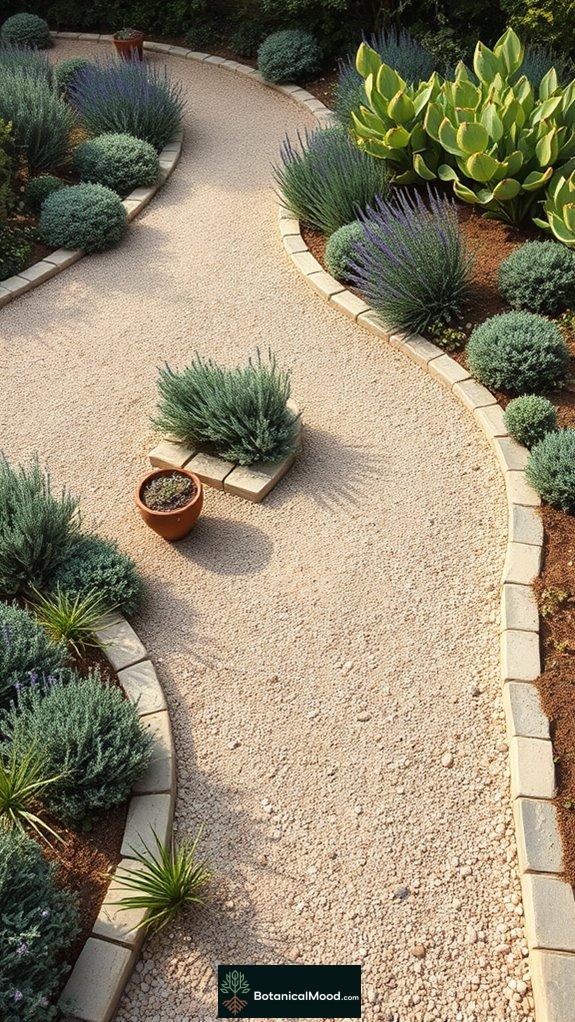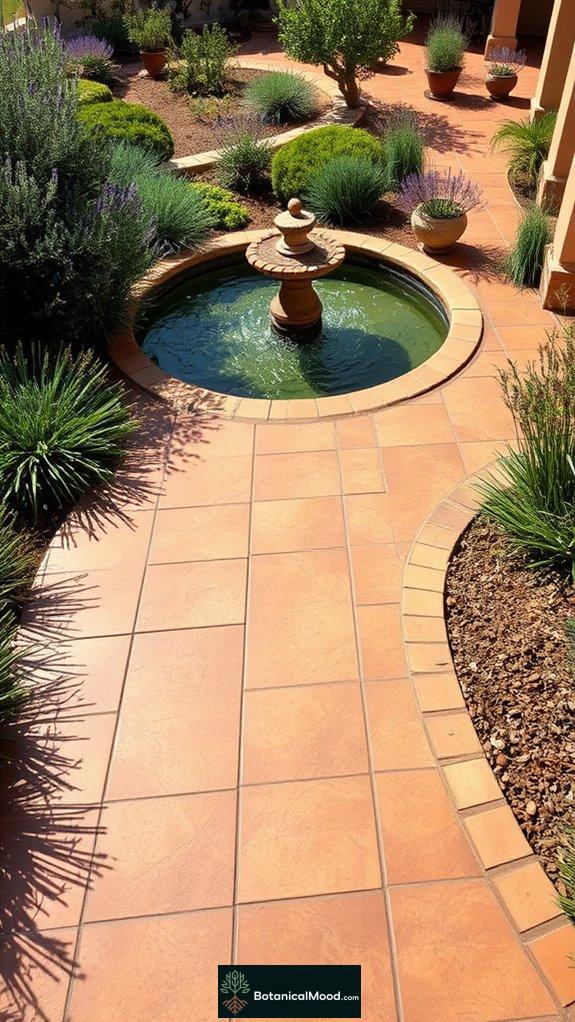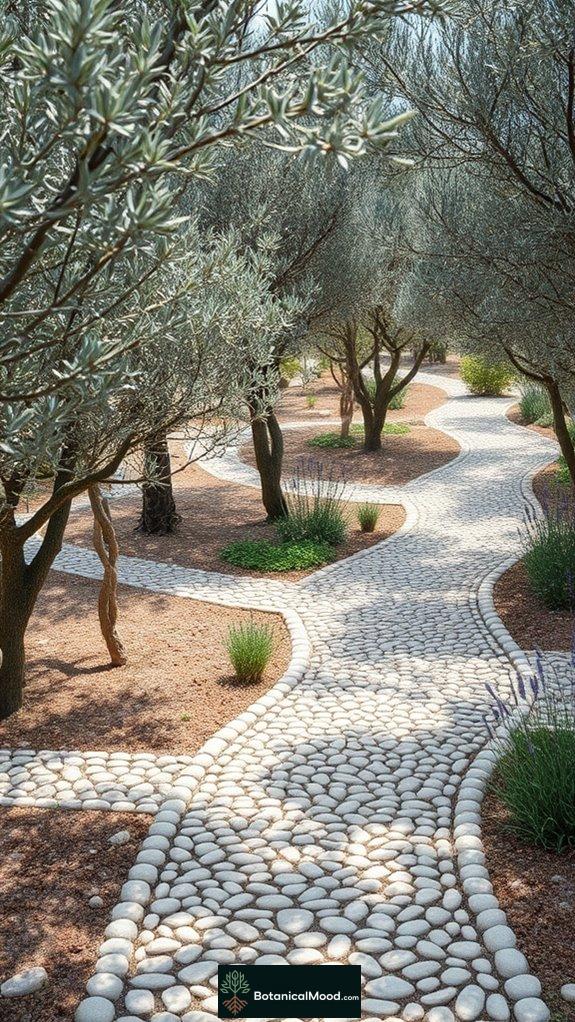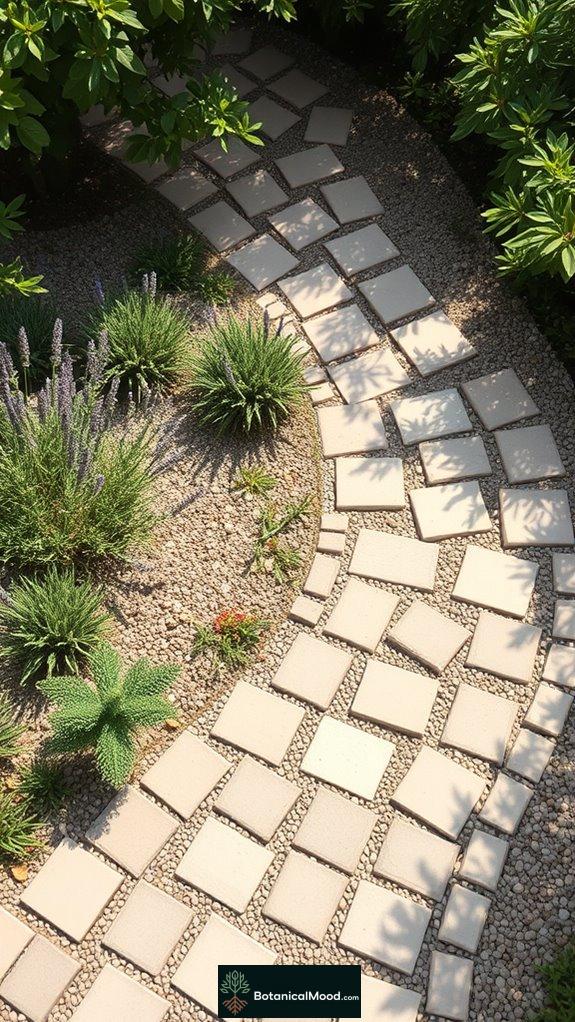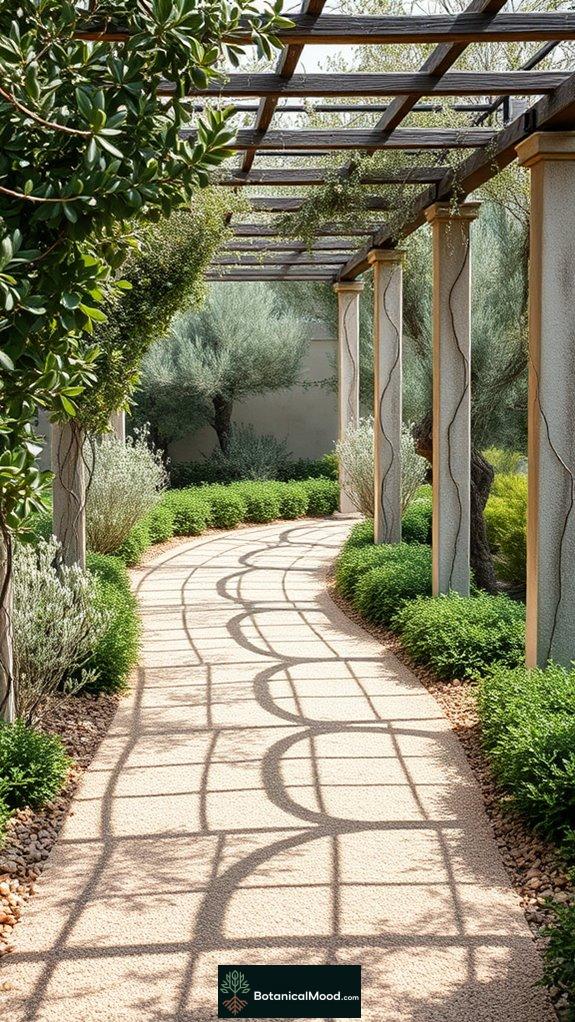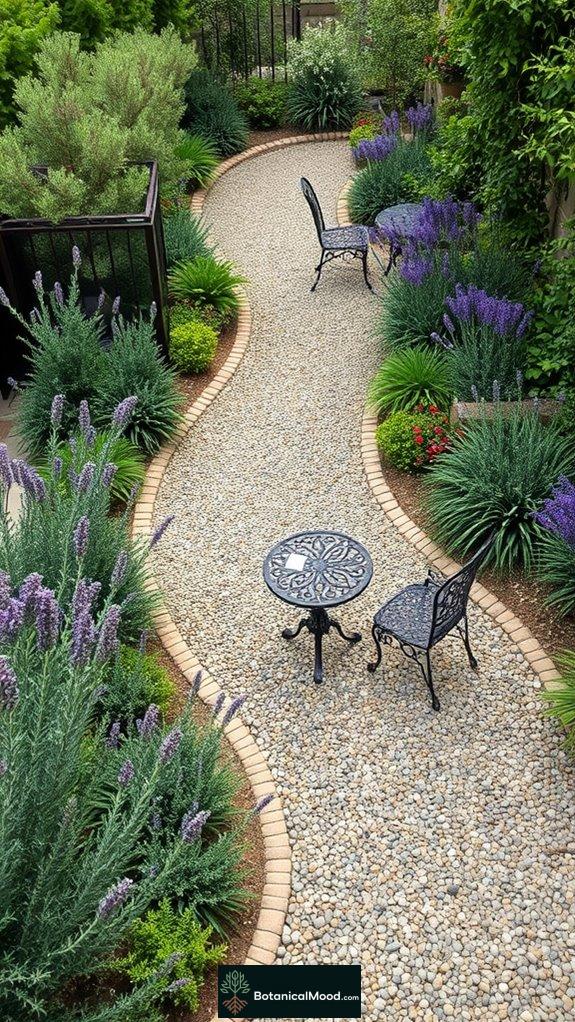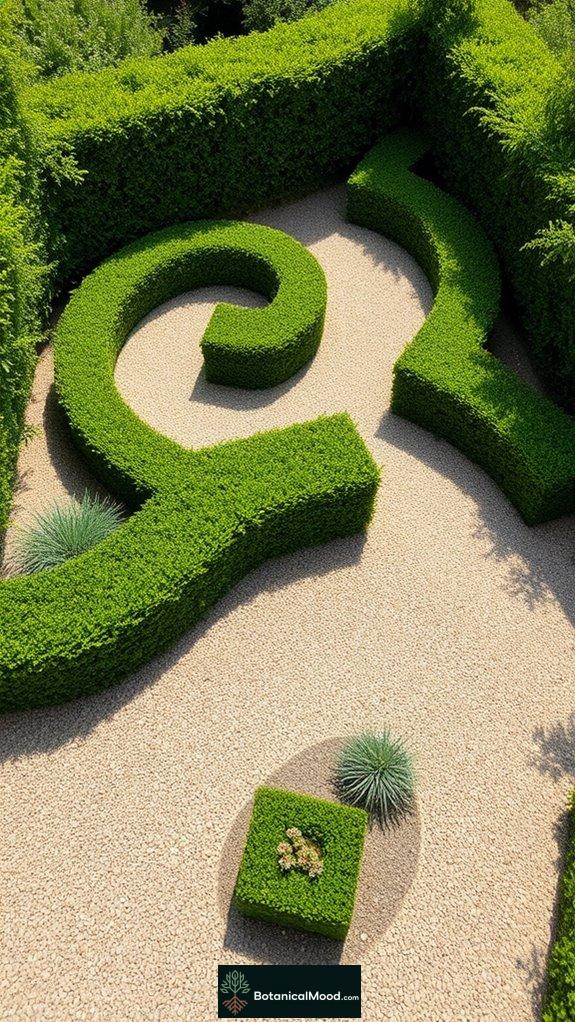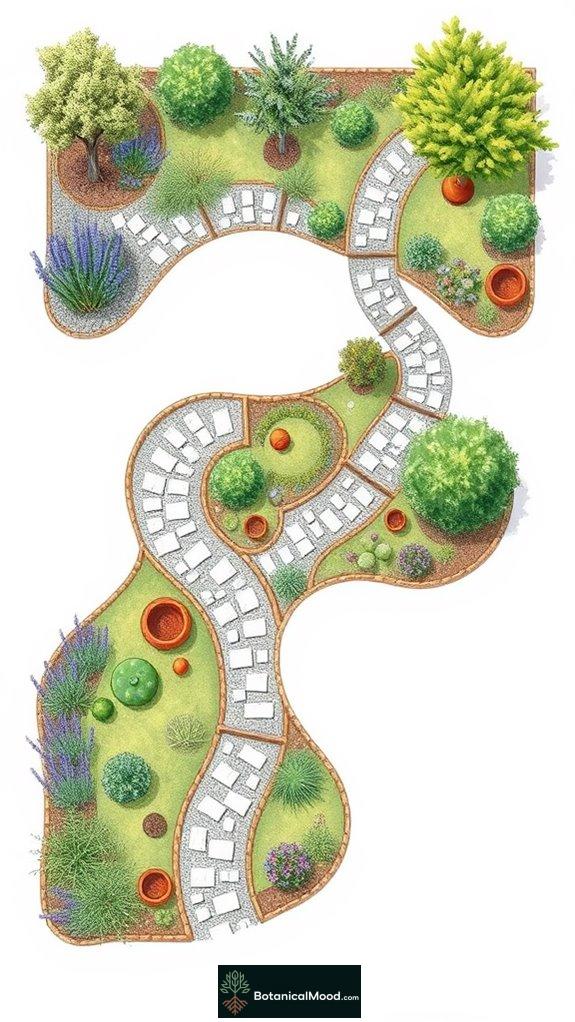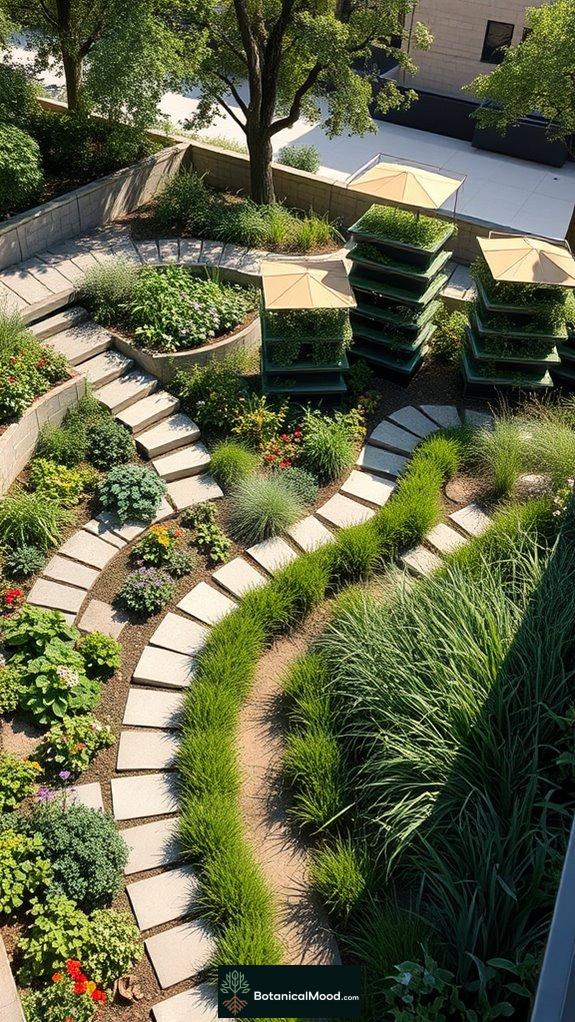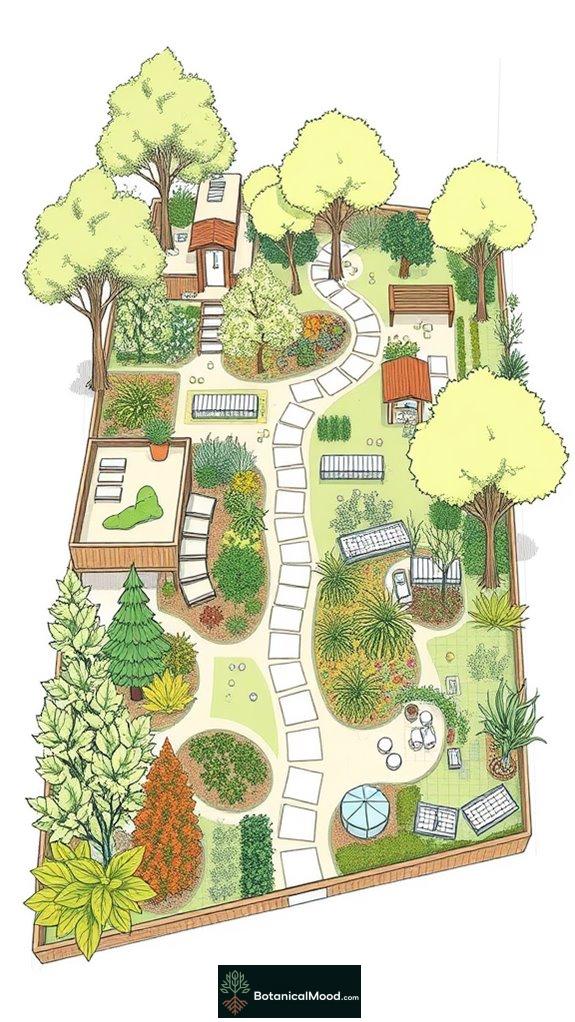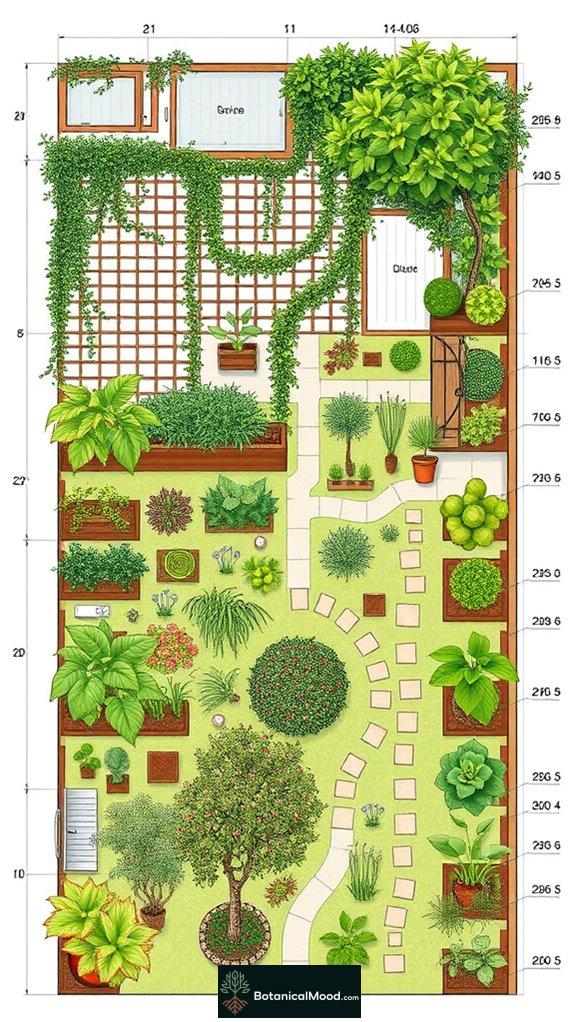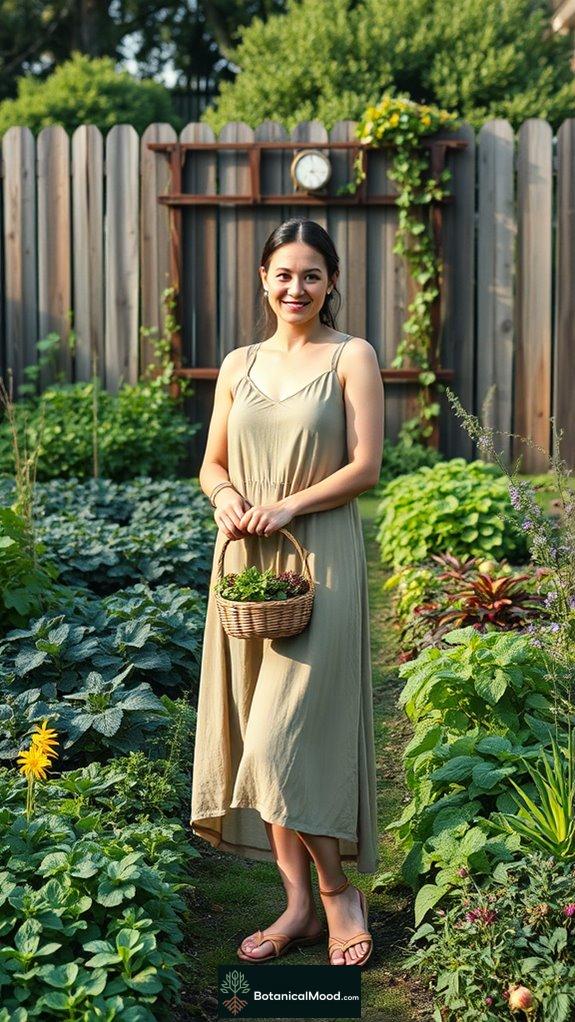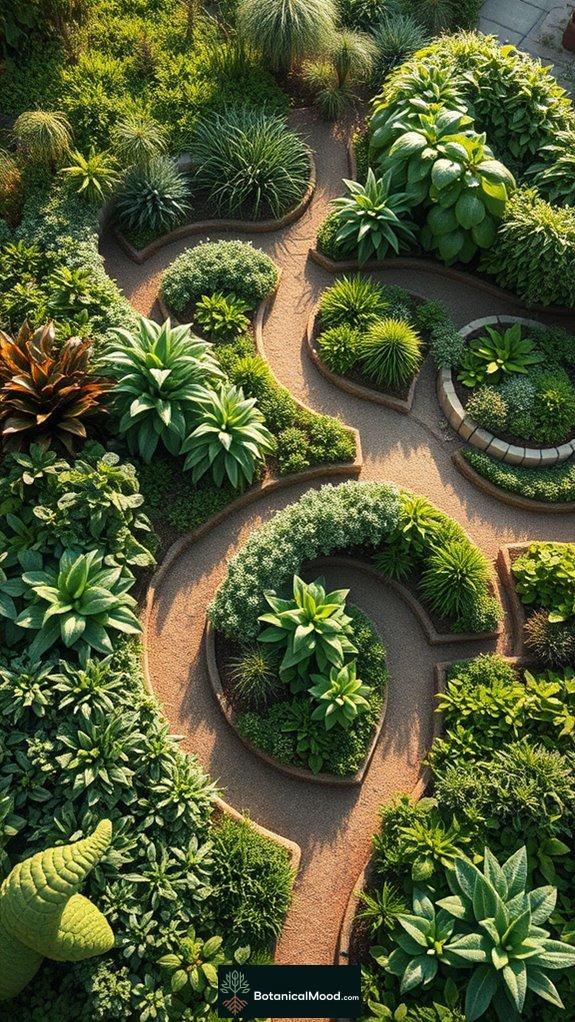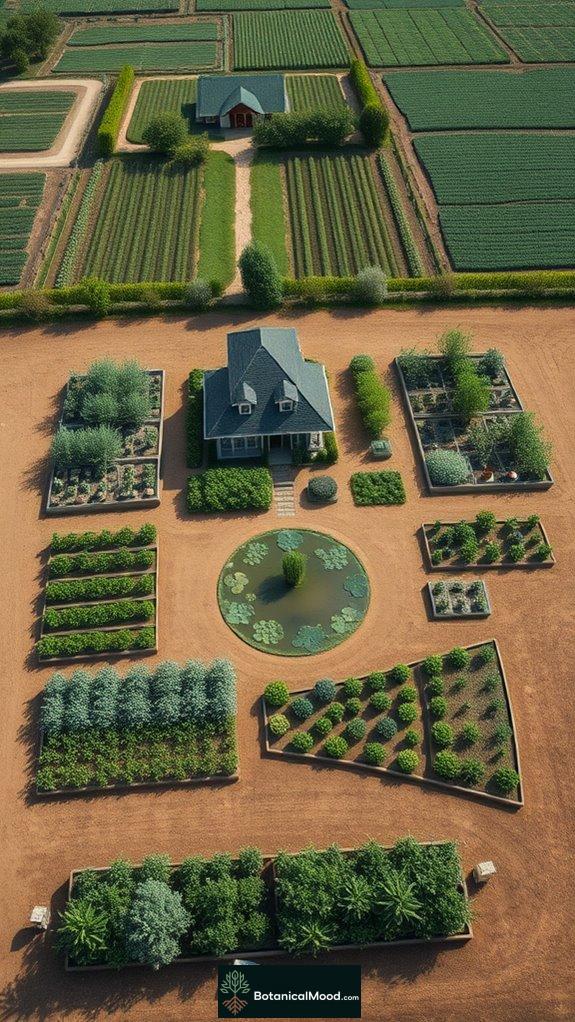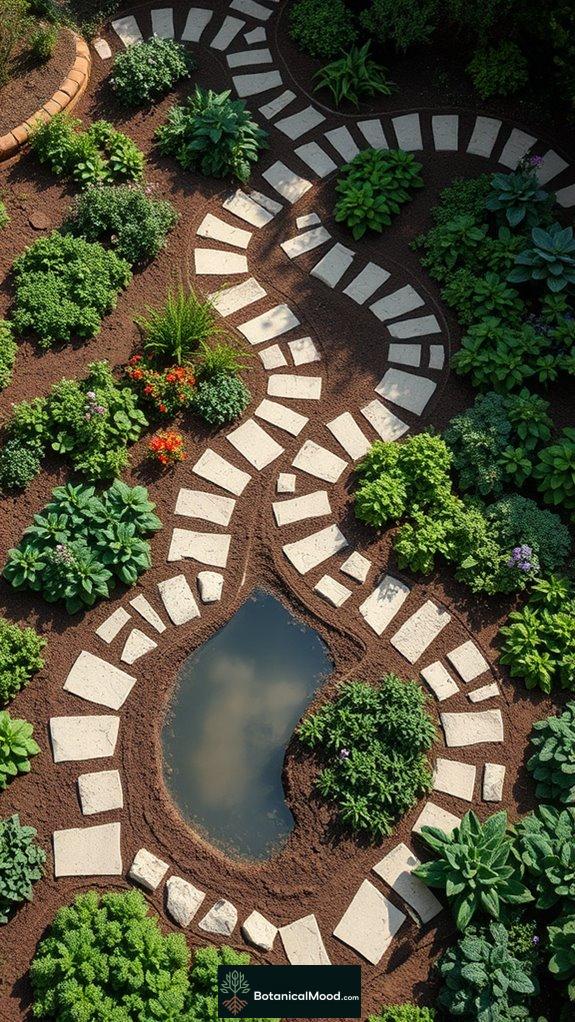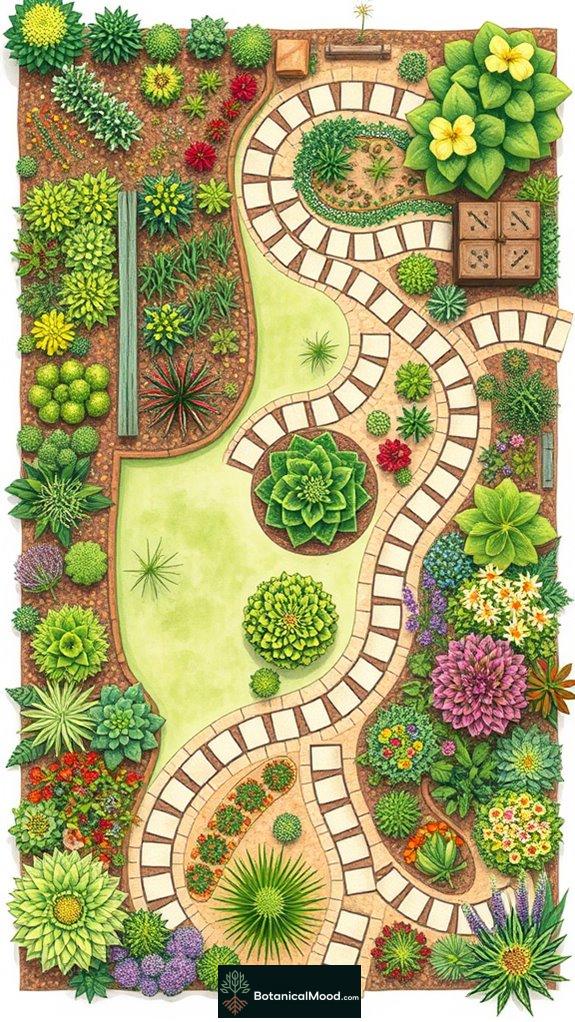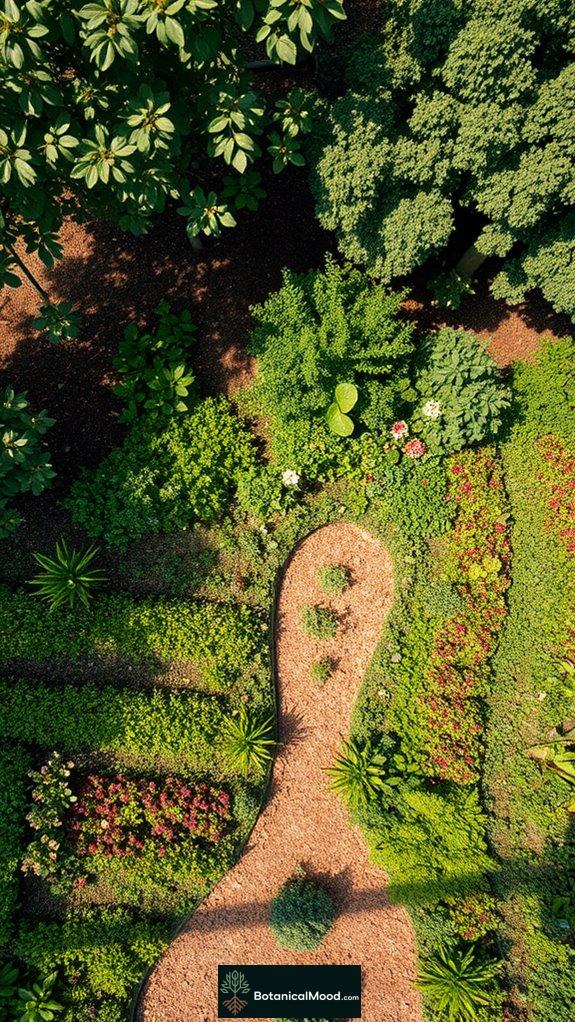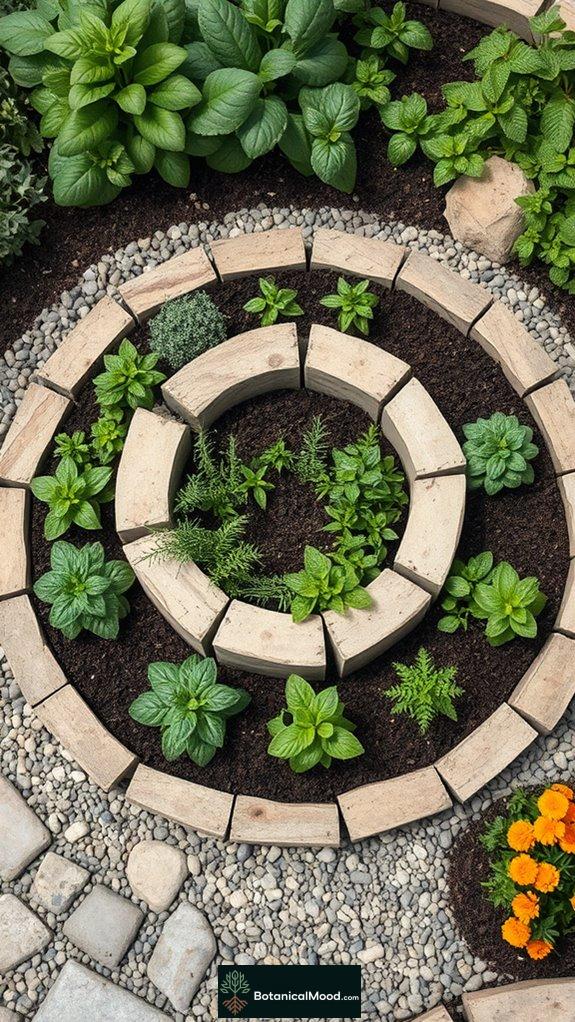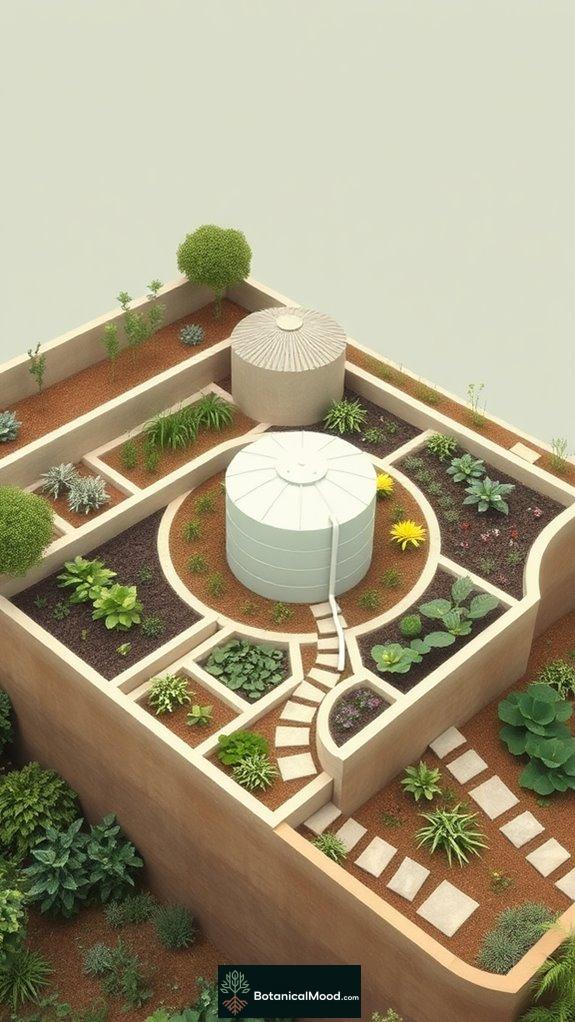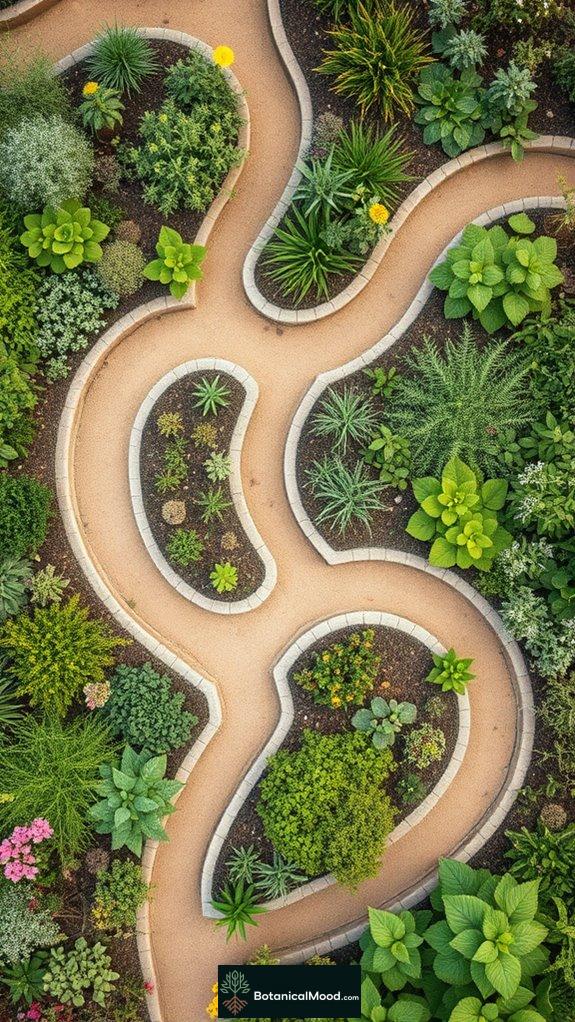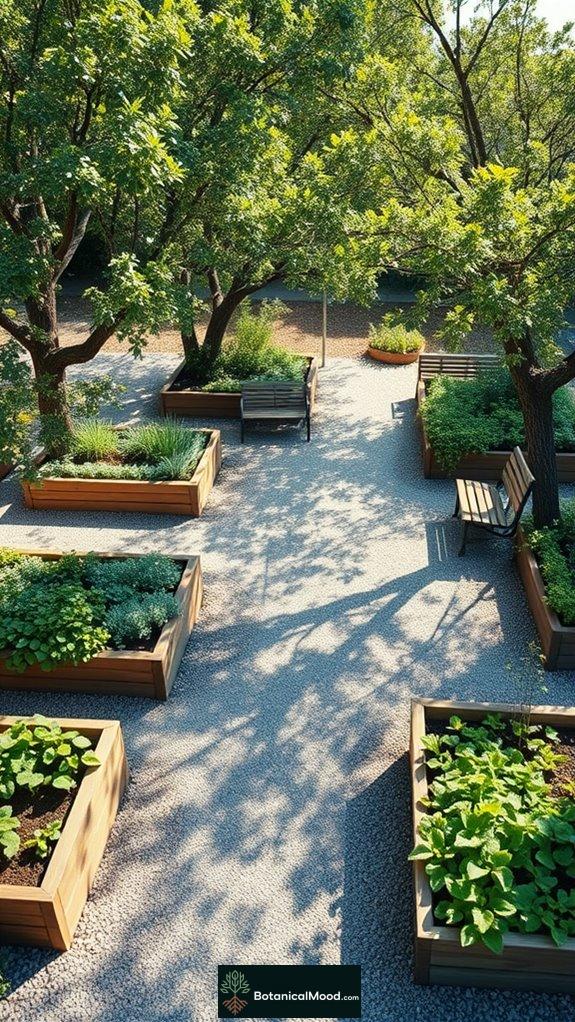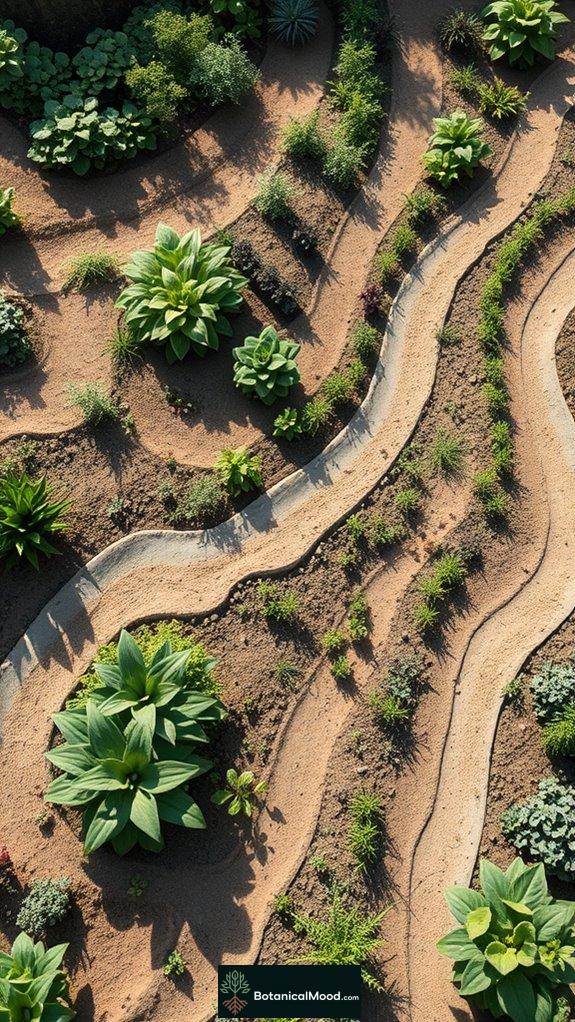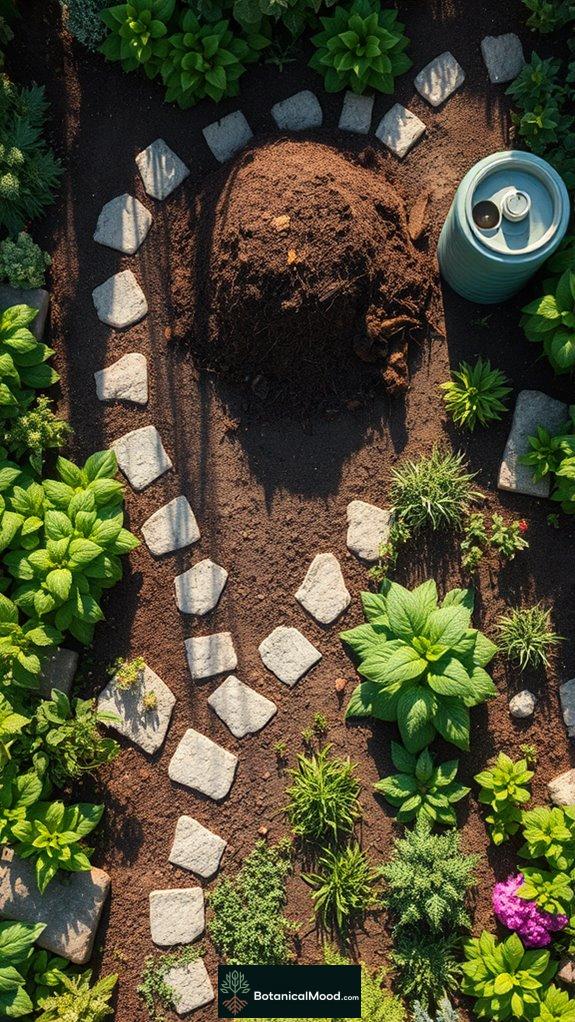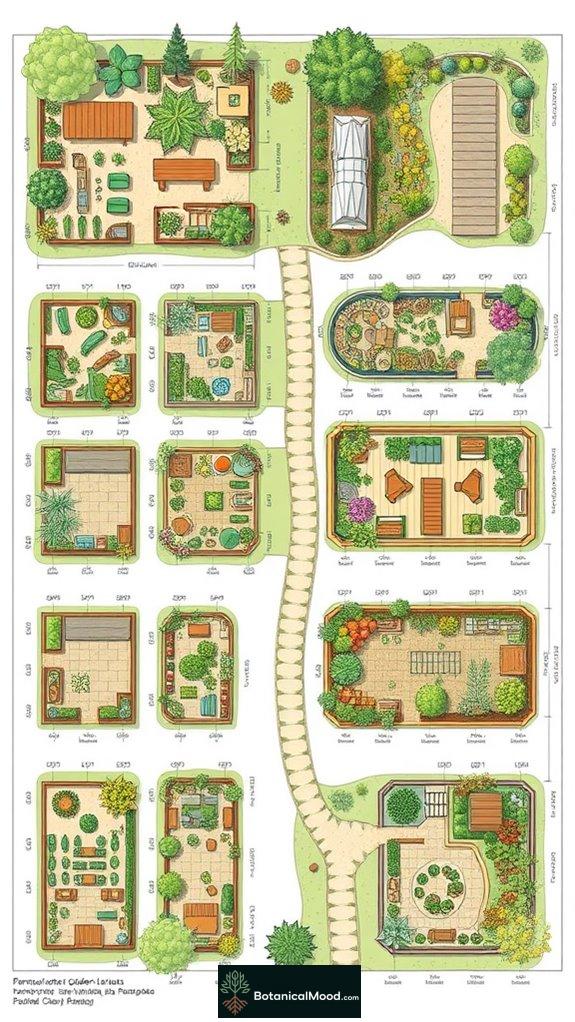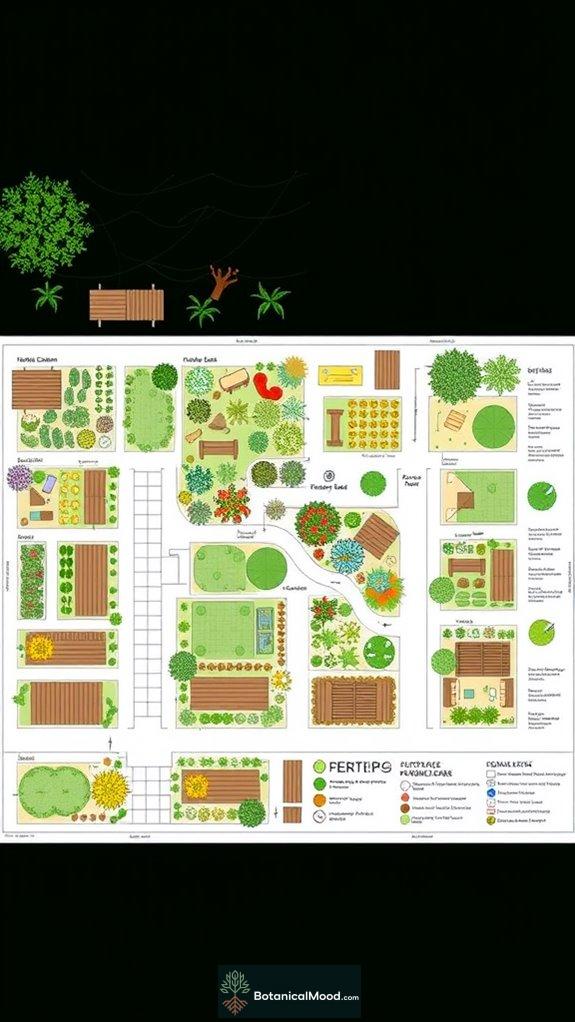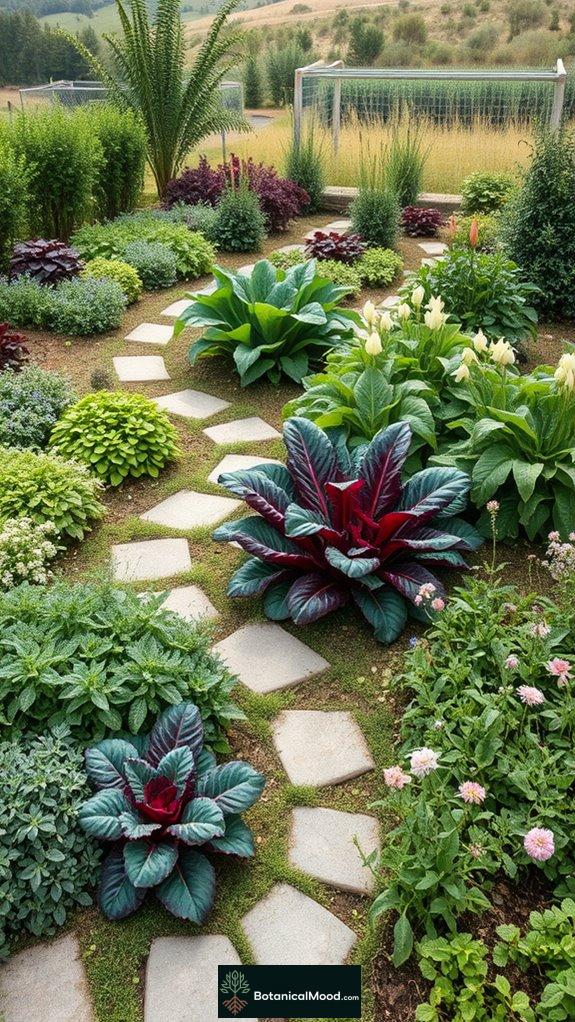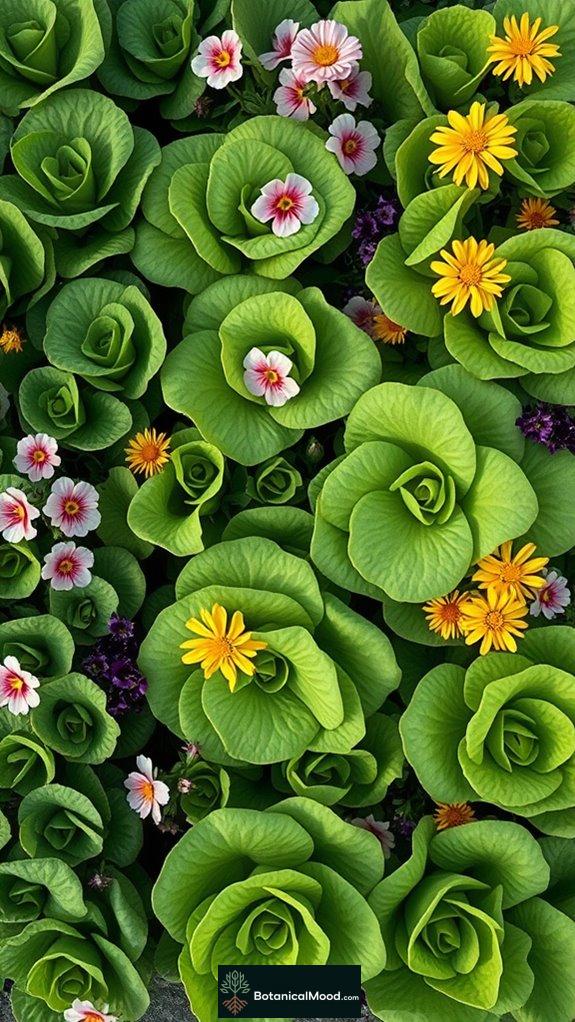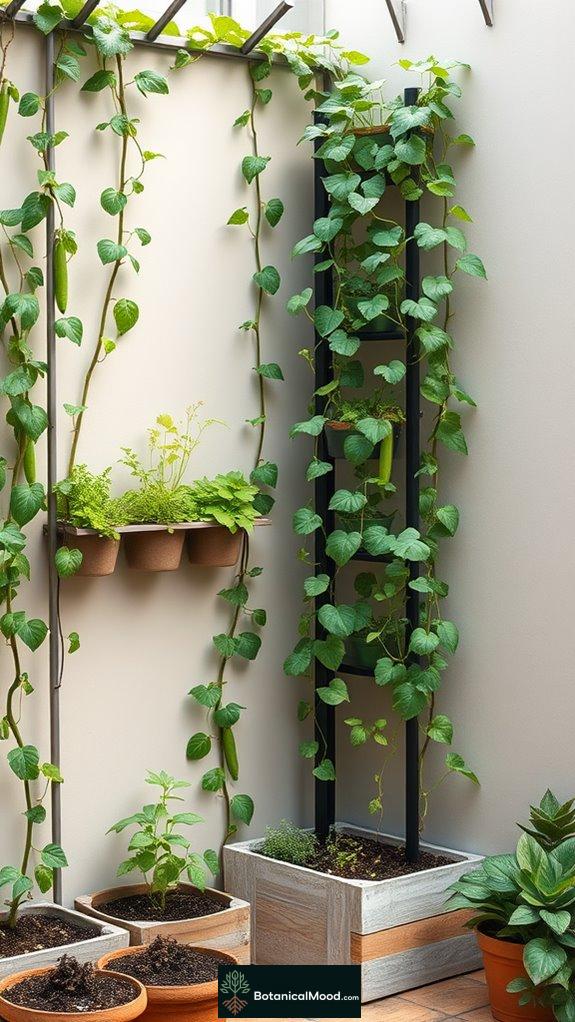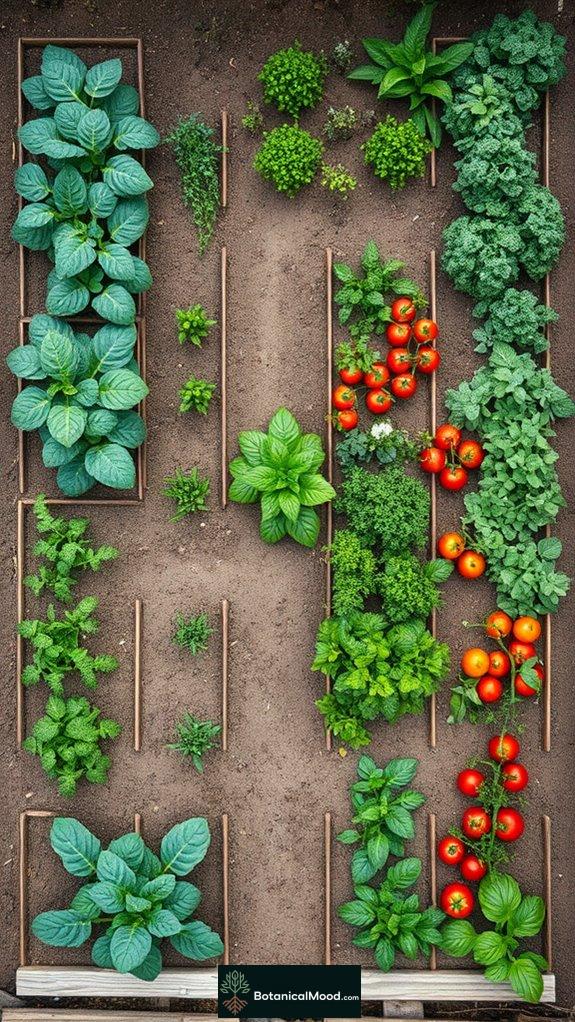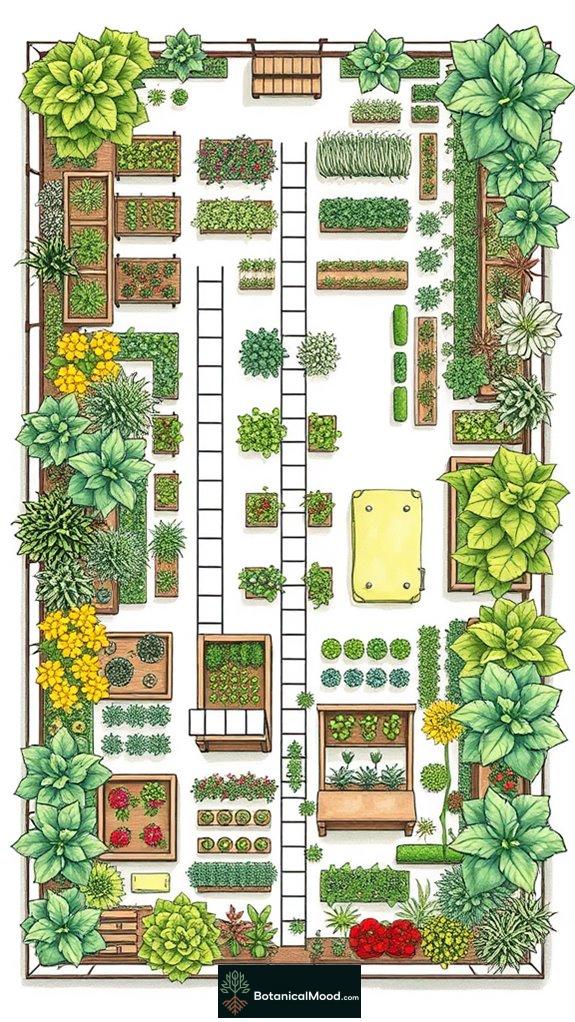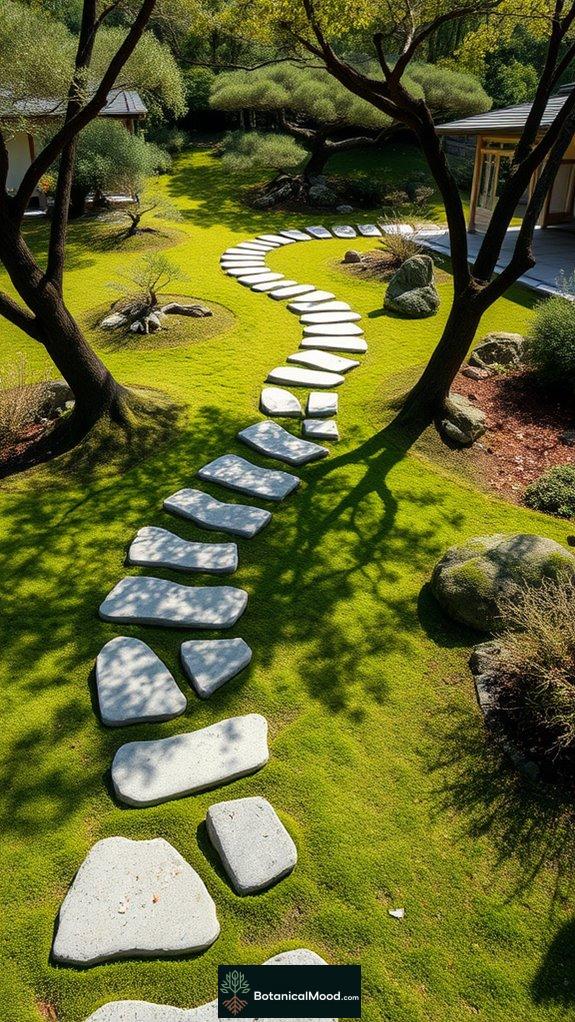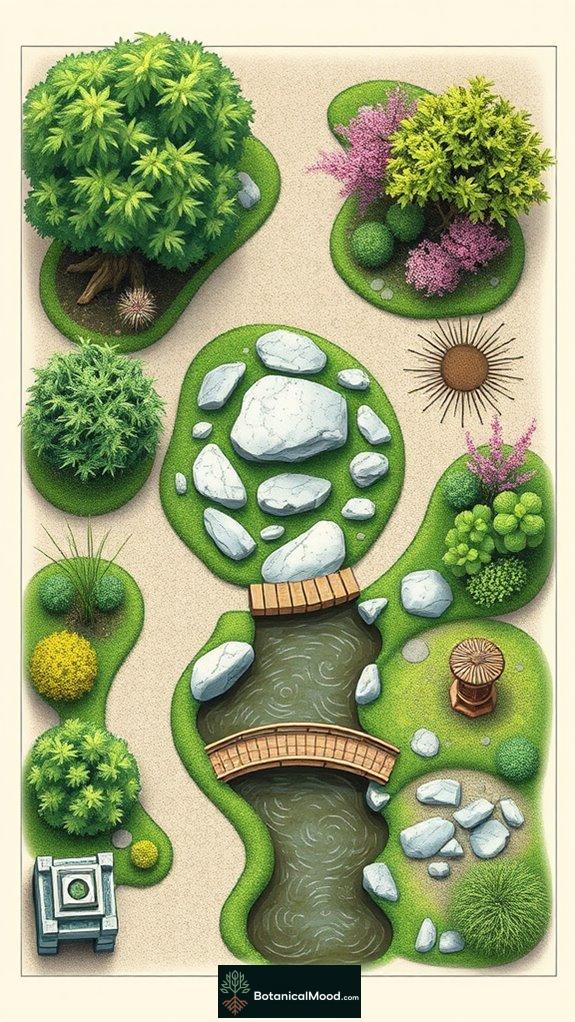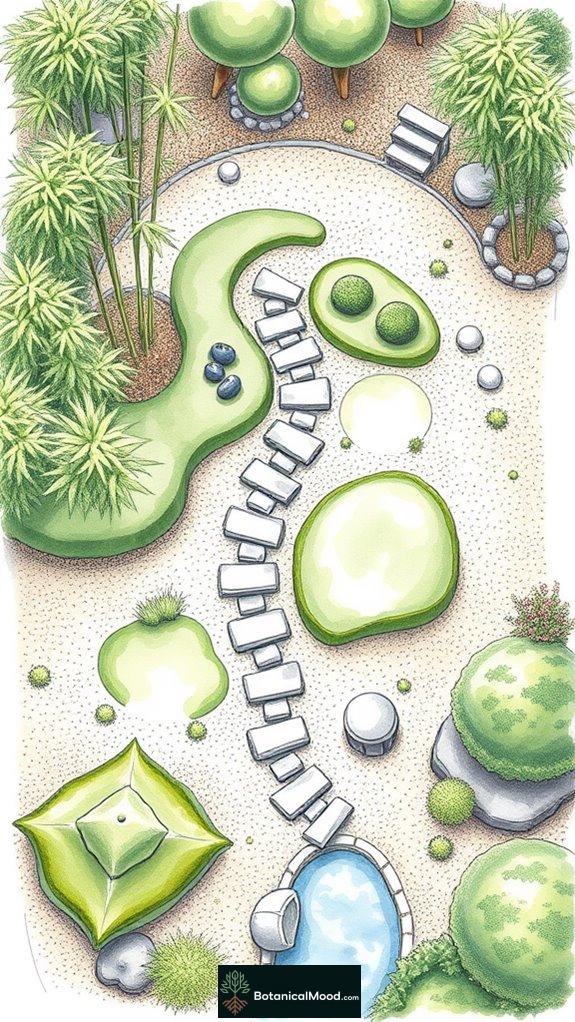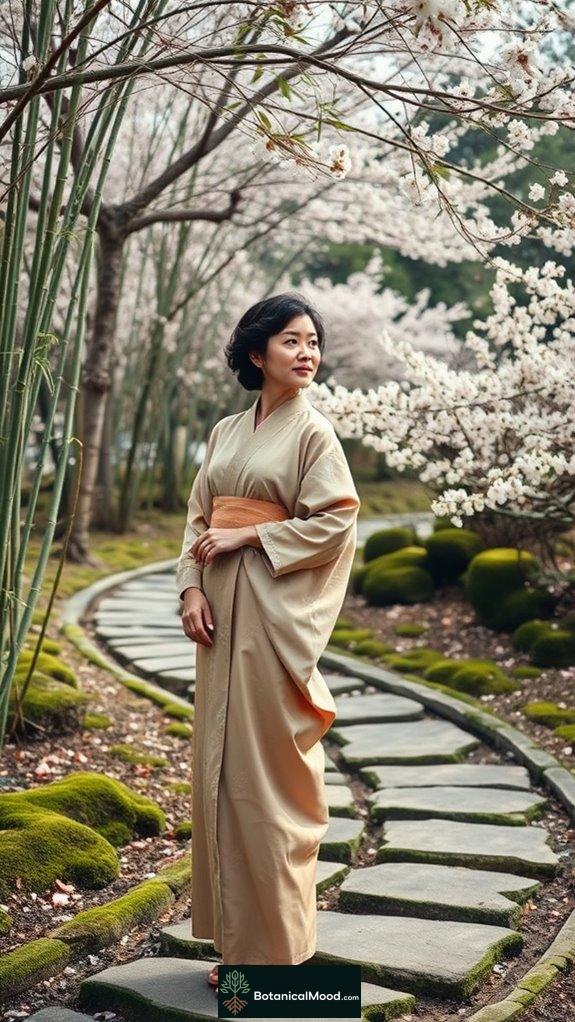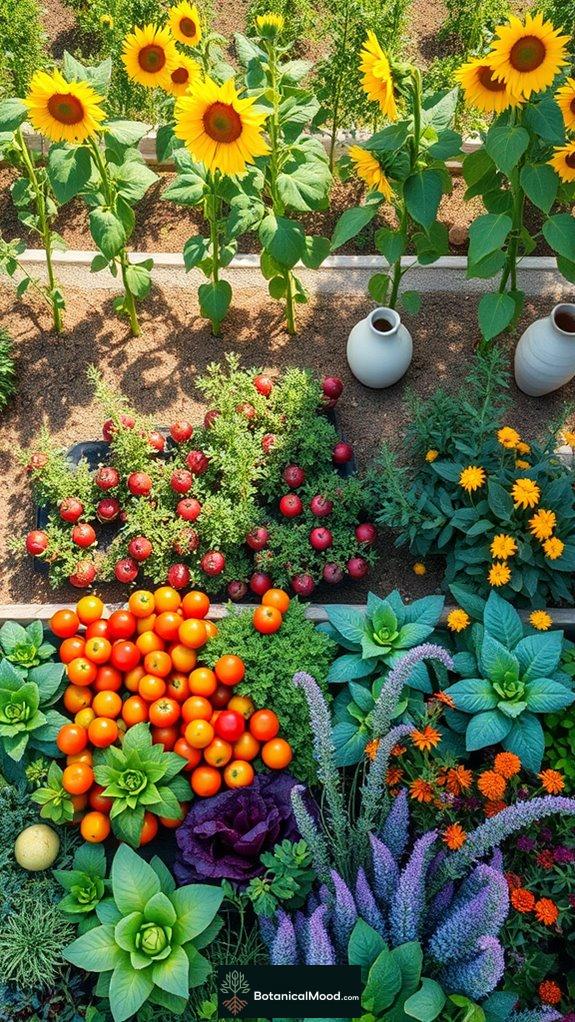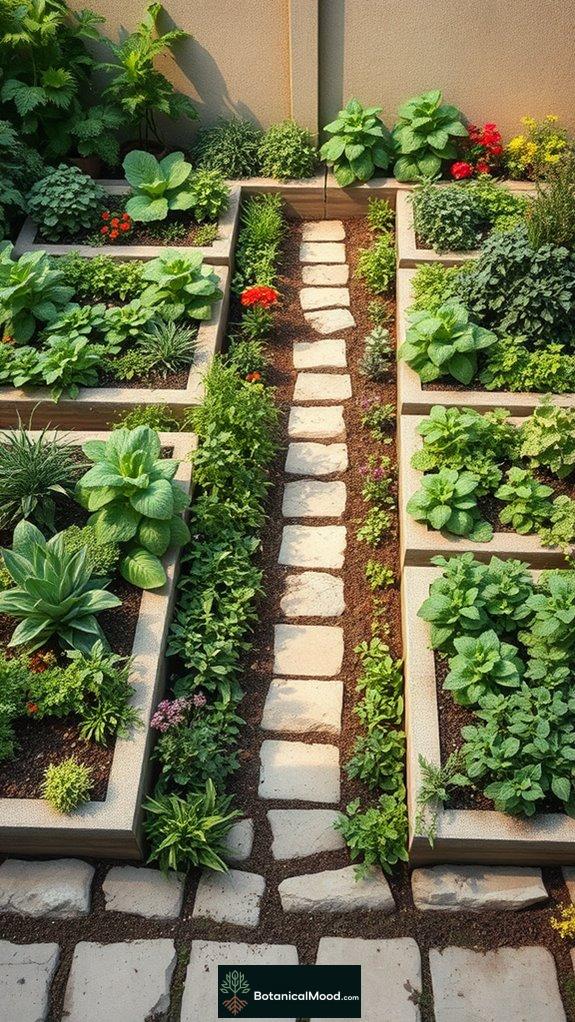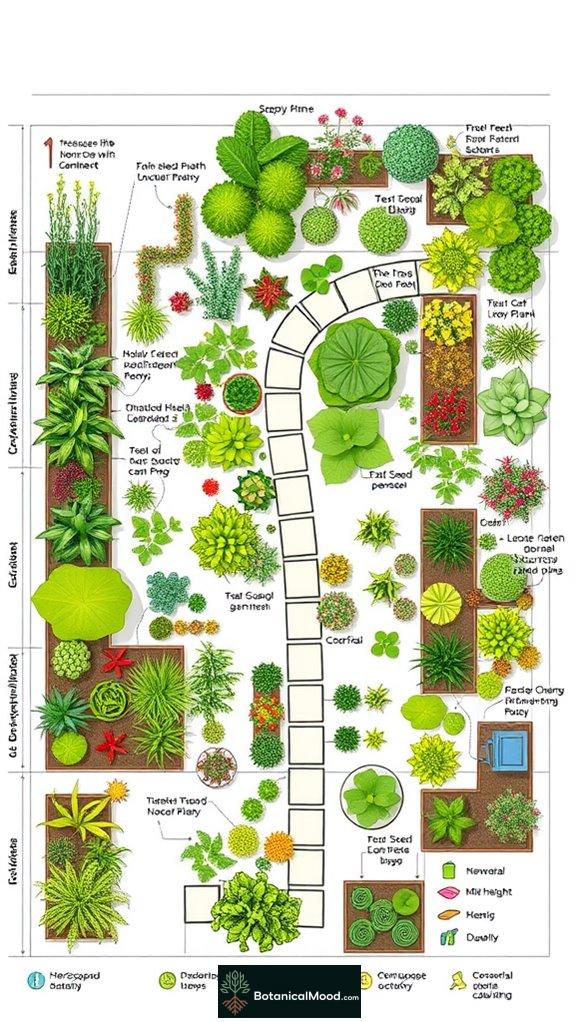Rock gardens embody tranquility through meticulous design and thoughtful arrangement. A Karesansui Zen garden, with its raked gravel and strategically placed rocks, invites mindfulness. Rock sculptures enhance visual interest while maintaining natural flow. An alpine rock garden showcases resilient, drought-tolerant plants amidst locally sourced stones. Miniature gardens pack charm into small spaces, while dry creek beds offer functional beauty. Each layout promotes serenity, allowing nature's beauty to shine, and further exploration reveals even more creative possibilities.
Quick Takeaways
- Incorporate asymmetrical arrangements of rocks and plants to mirror the natural world's uniqueness and enhance tranquility.
- Utilize gravel and raking techniques to symbolize flowing water, promoting a meditative atmosphere in the garden.
- Create focal points with larger rocks or stacked stones, inviting contemplation and reflection.
- Select drought-resistant plants that thrive in rocky conditions, ensuring a sustainable and low-maintenance design.
- Experiment with textures and lighting to enhance visual interest and create enchanting shadows in the garden space.
Karesansui (Dry Landscape) Zen Garden

Karesansui gardens, often called dry scenery Zen gardens, embody the essence of tranquility and simplicity, enchanting anyone who encounters their serene beauty.
Rooted in Zen philosophy, these gardens reflect cultural symbolism through their deliberate use of rocks and sand to represent mountains and flowing waters. Each element is carefully chosen to promote contemplation, encouraging a meditative state that invites reflection. The design emphasizes asymmetry to reflect the uniqueness of the natural world, enhancing the garden's overall appeal. The composition techniques employed in Karesansui gardens often create a harmonious balance between the elements, further deepening the viewer's experience.
As I explore the design principles behind these spaces, I appreciate how their minimalism enhances our connection to nature.
It's this harmony and balance that inspired me to create Botanical Mood, a space for celebrating the art of garden design.
Rock Sculpture and Arrangement
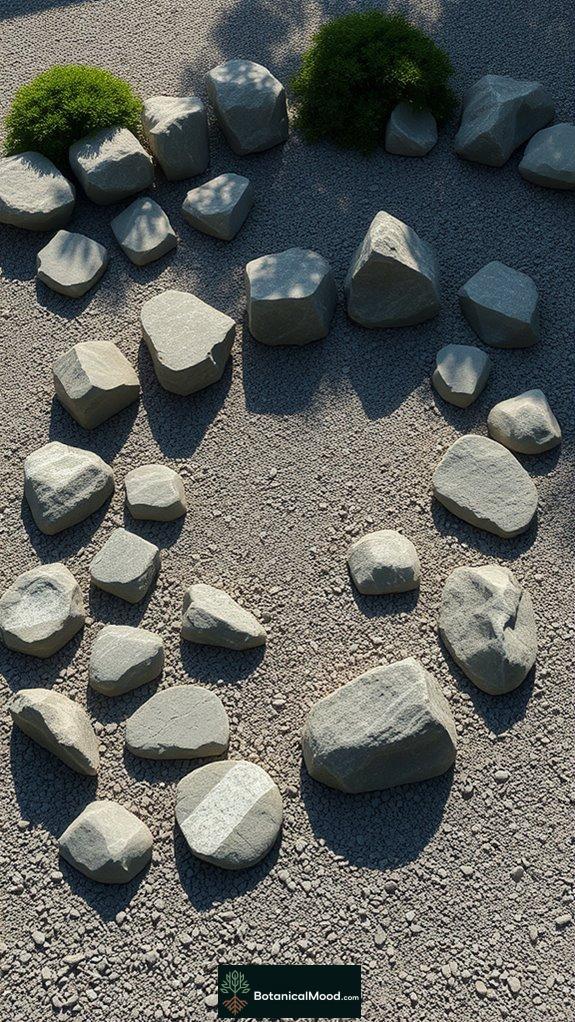
Rock sculpture and arrangement serve as the backbone of a mesmerizing garden design, merging artistry with nature to create visually stunning vistas. I've found that rock placement plays a vital role in establishing a natural flow, especially when using stones with unique shapes and contrasting stone textures. Arranging rocks in odd numbers and varying sizes adds depth and visual interest, making the garden feel more organic. Incorporating sculptural elements, such as stacked rocks, creates focal points that anchor the space, inviting contemplation and serenity. This is why I created Botanical Mood—to inspire others to achieve tranquility through innovative garden design. Additionally, using proportional materials ensures that stones and plants are in scale with your home and yard, enhancing the overall harmony of the garden. The careful selection of contemporary zen garden boulder artistry can elevate your space and create a serene atmosphere.
Alpine Rock Garden

Creating an enchanting alpine rock garden opens the door to a unique world where the beauty of nature and the artistry of design come together. Incorporating natural stone elements from alpine mountainous terrains can enhance the authenticity and rugged charm of your garden.
With careful alpine plant selection, I choose compact, drought-resistant varieties that thrive in chilly, rocky conditions. Arranging granite and basalt boulders mimics their natural mountainous environments, enhancing visual balance and harmony. Incorporating hardy, adaptable plants ensures that the garden remains vibrant and resilient throughout the seasons.
Ensuring proper rock garden drainage is essential; I mix sharp sand into the soil for ideal moisture control. This blend allows each plant to flourish while providing year-round interest.
My passion for innovative gardening shines through in each carefully curated detail, inspiring others to create their tranquil havens.
Miniature Rock Garden
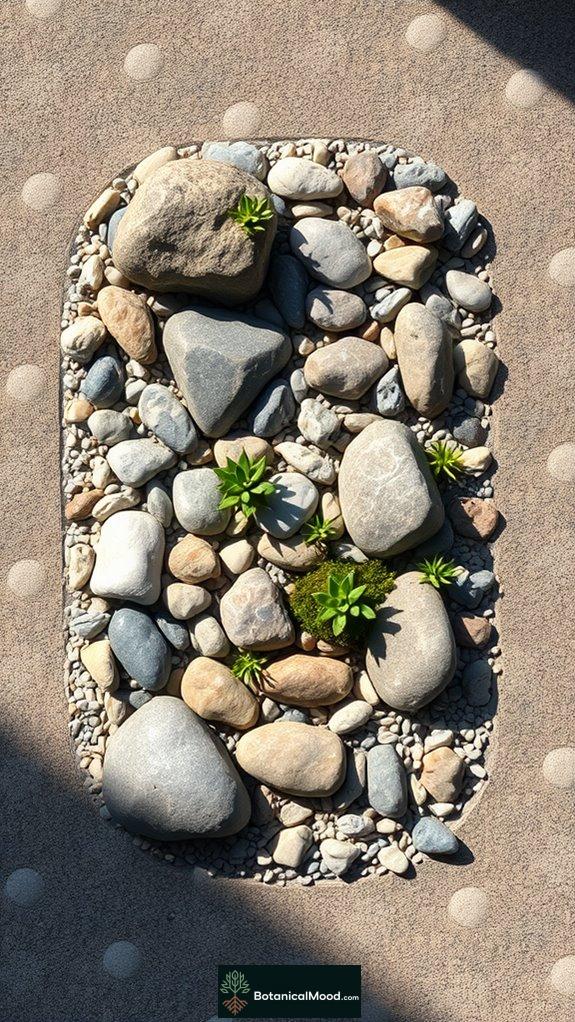
A miniature rock garden can transform even the smallest of spaces into an enchanting oasis. With the right miniature plant selection, you can create a vibrant display that thrives in tight corners, like balconies or tabletops.
I love incorporating a mix of textures using rocks, pebbles, and gravel, which adds visual interest. Creative customization allows me to adapt themes, whether it's Zen simplicity or Mediterranean charm.
Balancing odd-numbered groupings of stones and varying plant heights helps achieve harmony. This delicate artistry brings tranquility to my surroundings, inspiring my passion for innovative gardening, which is why I created Botanical Mood. Additionally, incorporating geometric forms can enhance the sculptural quality of your design, bringing a modern touch to the serene atmosphere.
Dry Creek Bed
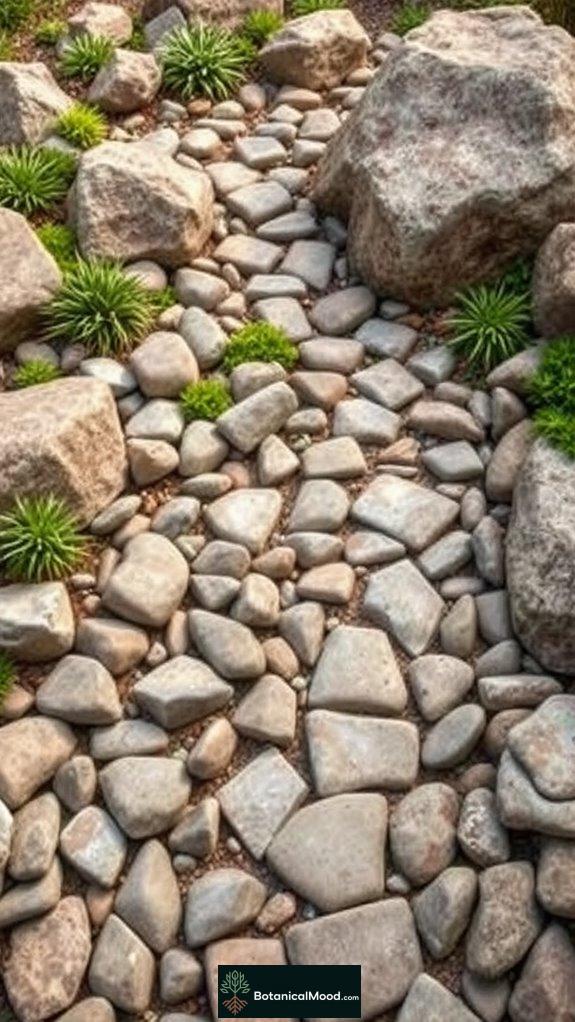
While designing outdoor spaces, I've often found that a dry creek bed can serve as both a functional and aesthetic feature in a garden.
A dry creek bed beautifully merges functionality and aesthetics, enhancing both drainage and visual appeal in any garden.
This innovative element enhances drainage while showcasing beautiful rock textures. I love using rounded stones for a natural flow, varying their sizes to create visual interest. Large boulders can anchor the turns, adding stability and charm.
Incorporating stepping stones not only invites exploration but also harmonizes the overall design. Innovative asymmetrical stone arrangements can elevate the visual appeal of your dry creek bed, adding a modern twist to traditional landscaping.
With the right plants and terrain fabric, a dry creek can transform any yard into a serene oasis. It's one of the many inspirations I share on Botanical Mood.
Riverbed With Boulder Accents
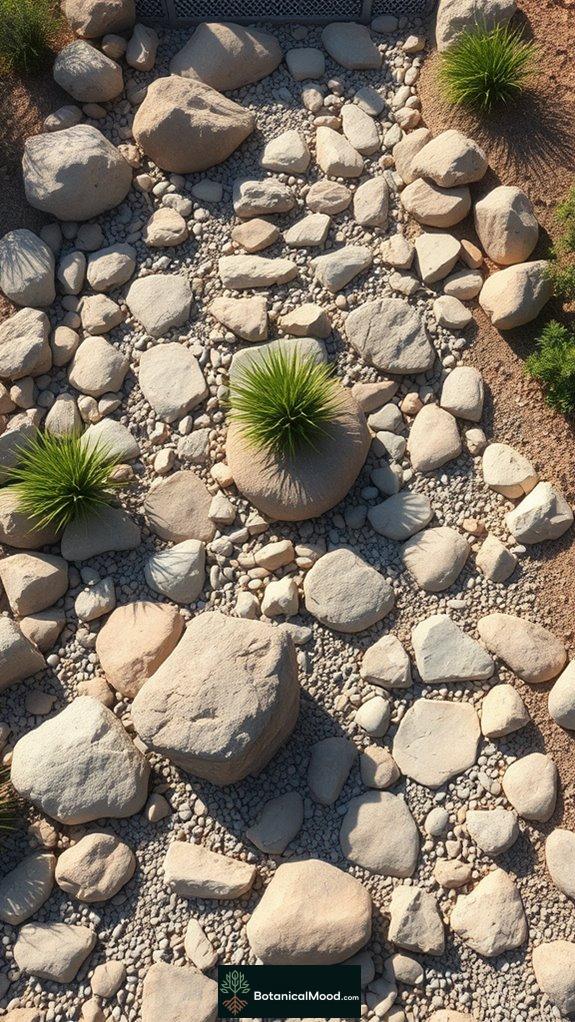
When designing a riverbed with boulder accents, you can create a stunning scenery that mimics the natural beauty of flowing water.
Incorporating river rock aesthetics, I find that varying boulder sizes adds depth and interest. Large boulders act as focal points, while smaller stones harmonize around them, creating a cohesive visual flow.
To enhance the zen experience, I recommend selecting drought-tolerant plants that complement the boulder harmony. Additionally, using sustainable sculptural elements can elevate the aesthetic appeal of your rock garden.
Utilizing gravel or pebbles fills gaps effectively, and serpentine patterns provide a natural look.
This innovative approach transforms your space into a peaceful retreat, which is why I created Botanical Mood—to inspire your garden journey.
Trough Rock Garden

Trough rock gardens present an exciting opportunity to create miniature settings that can fit into even the smallest of spaces.
I love how these gardens offer numerous trough garden benefits, such as portability and low maintenance, making them perfect for any gardening enthusiast.
With durable materials like hypertufa or metal, I can design a unique arrangement of rocks and succulent varieties.
Elevating the troughs guarantees proper drainage, while diverse textures and colors enhance visual appeal.
These gardens not only conserve water but also attract beneficial wildlife, adding charm. Incorporating modern landscape lighting can further enhance the beauty of these gardens during the evening hours.
At Botanical Mood, I aim to inspire your creativity in these delightful miniature environments.
Hidden Pathway Bridge
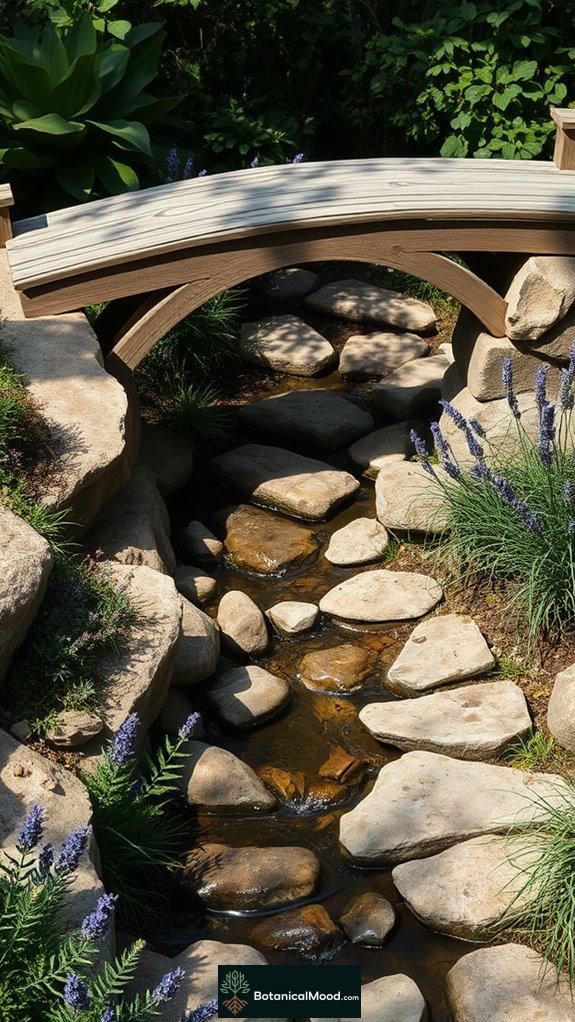
A hidden pathway bridge can transform your garden into an enchanting escape, inviting exploration and serenity.
Imagine strolling along a meandering path, where bridge aesthetics harmonize with nature. Whether crafted from wood or stone, the bridge serves as a focal point, connecting distinct garden areas.
I've found that incorporating plants creates a living bridge, enhancing the natural look while inviting tranquility.
Strategic lighting illuminates the pathway at night, enhancing its allure. With aromatic plants nearby, the sensory experience becomes even more profound. Additionally, incorporating therapeutic landscape elements can further promote mental wellness and relaxation.
This innovative design element fosters a peaceful atmosphere, allowing you to appreciate the beauty of your garden in a truly immersive way.
Stepping Stone Rock Garden
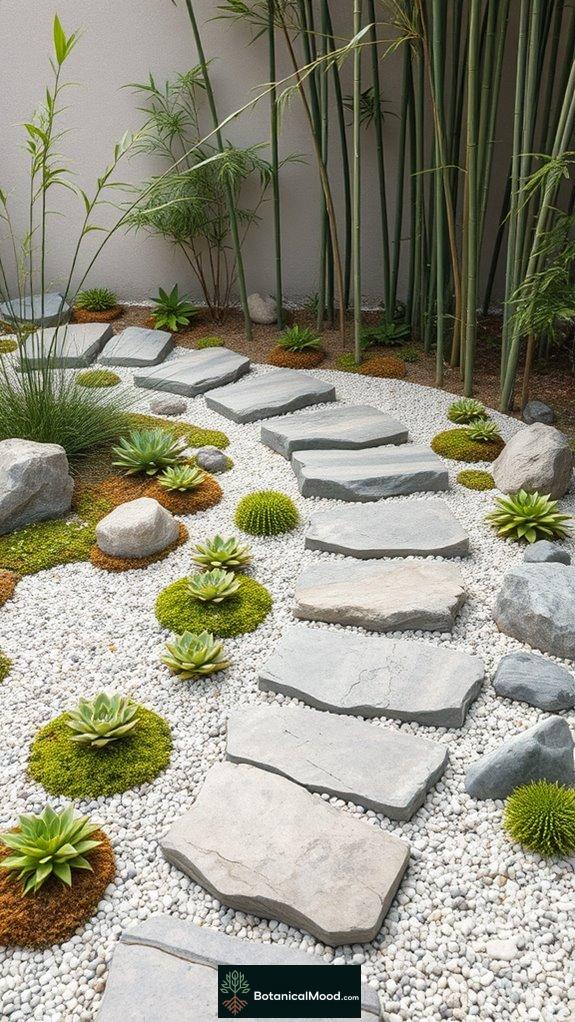
Creating a stepping stone rock garden brings an opportunity to connect various elements of design while enhancing the natural beauty of your surroundings. I love how stepping stone placement allows for an artistic flow, effortlessly guiding visitors through the garden's lush textures and natural aesthetics. Additionally, incorporating modern lighting techniques can elevate the overall ambiance, highlighting key features and creating enchanting shadow effects in the evening.
Naturalistic Rock Garden
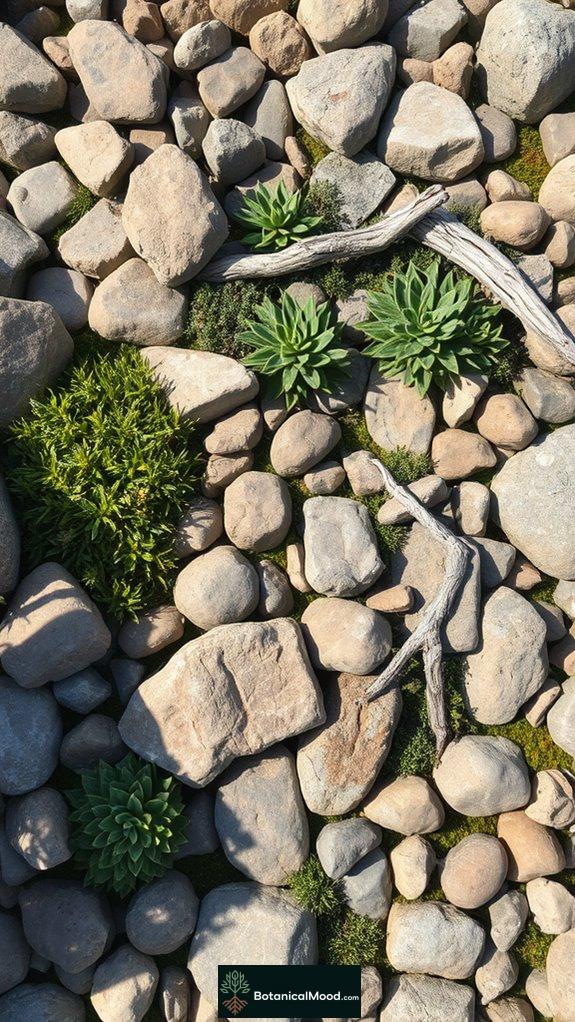
Naturalistic rock gardens capture the essence of nature's beauty by seamlessly blending rocks and plants into a harmonious setting.
Naturalistic rock gardens beautifully merge stones and plants, creating a tranquil and harmonious representation of nature's splendor.
In designing my own garden, I focus on thoughtful rock arrangement, using locally sourced stones in various sizes and colors to enhance visual interest.
For plant selection, I choose resilient, low-maintenance species that thrive in my local climate, ensuring they're spaced for ideal growth.
Elevation changes create depth, while adding driftwood or moss introduces natural elements. Additionally, incorporating xeriscape principles allows for a sustainable and water-efficient design that supports local wildlife.
Serene Stone Arrangement Techniques

In my efforts to cultivate a serene environment, I focus on stone arrangement techniques that foster balance and tranquility within the garden.
By thoughtfully considering stone placement, I can create a harmonious atmosphere that naturally draws the eye. Here are some techniques I find particularly effective:
- Use odd numbers of stones for a more organic look.
- Incorporate a variety of textures for visual interest.
- Arrange stones in asymmetrical groupings for a natural feel.
- Select interesting shapes that captivate attention.
- Position larger rocks as focal points for meditation.
These techniques enhance the beauty of my rock garden, inspiring deep reflection and peace. Additionally, employing biomorphic design principles can further enhance the natural harmony of the space.
Zen-inspired Gravel Patterns

Zen-inspired gravel patterns offer a unique approach to enhancing the tranquility of a garden space. These designs not only embody gravel symbolism, representing water and natural elements, but also invite contemplation. I love using raking techniques to create wavy lines that mimic flowing streams or circular patterns that symbolize harmony. Experimenting with different textures, like finely crushed white gravel, adds visual interest, enhancing the meditative quality of the garden. Incorporating natural stone techniques can further elevate the serene atmosphere, providing a grounding presence amidst the soft textures of gravel.
Contemporary Minimalist Rock Design
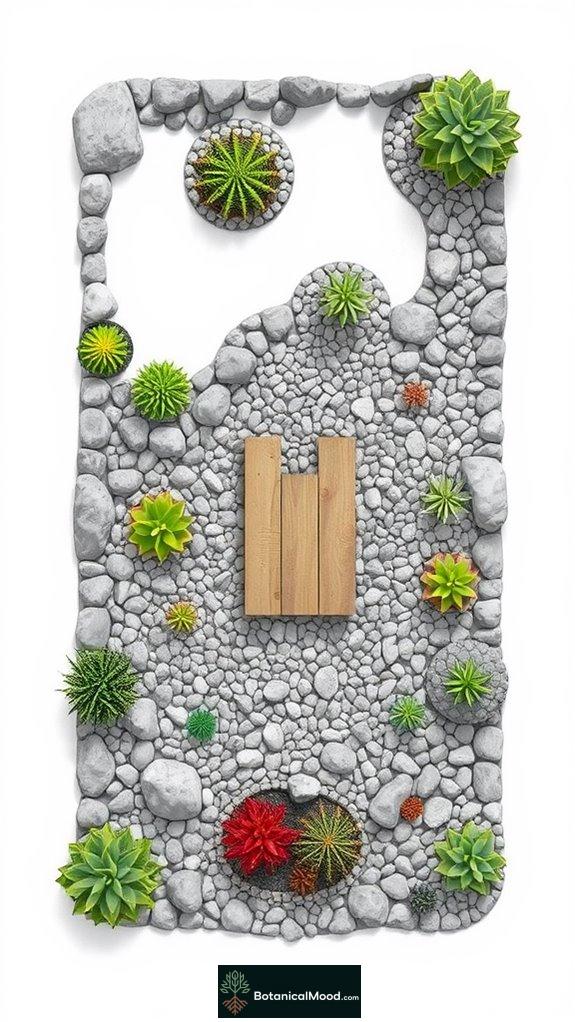
Contemporary minimalist rock design captivates with its elegant simplicity, showcasing the beauty of nature through carefully curated elements. I find that this approach emphasizes minimalist aesthetics and diverse rock textures, creating a serene environment.
Contemporary minimalist rock design highlights nature's beauty through elegant simplicity and thoughtfully selected elements.
- Low-maintenance plantings like succulents
- Geometric patterns using rocks for visual interest
- Natural materials, such as untreated wood and stone
- Simplified landscaping features like pebble paths
- Modern accents, such as metal features, sparingly added
Incorporating low-maintenance plantings allows for a sustainable garden that thrives with minimal effort.
Garden Maintenance Responsibilities

Maintaining a rock garden involves a series of responsibilities that assure the space remains both beautiful and functional. Regular garden upkeep is essential; water spraying, raking, and using a leaf blower keep the garden aesthetically pleasing.
A maintenance schedule should include weed monitoring and hand-picking to prevent overgrowth, while seasonal assessments guarantee plant health and structural integrity.
Careful pruning and moisture monitoring promote thriving plants, enhancing tranquility. Furthermore, addressing erosion and replenishing rocks maintains visual appeal. Incorporating sustainable water practices into your maintenance routine can significantly enhance the garden's resilience and beauty.
References
- https://greensaus.com/zen-garden-ideas/
- https://onehometherapy.com/10-innovative-zen-garden-ideas-to-create-your-ultimate-peaceful-retreat/
- https://www.arkaenergy.com/learn/rock-garden-ideas
- https://flourishbydesign.com/the-tranquility-of-a-zen-rock-garden/
- https://www.thespruce.com/zen-garden-ideas-7556607
- https://japanko-official.com/zen-garden-benefits/
- https://asphaltmaterials.net/blogs/blog/making-a-zen-rock-garden
- https://matcha-jp.com/en/2727
- https://bayaggregates.com/japanese-zen-gardens/introduction-to-japanese-zen-gardens/
- https://www.gardendesign.com/landscape-design/rock-gardens.html


